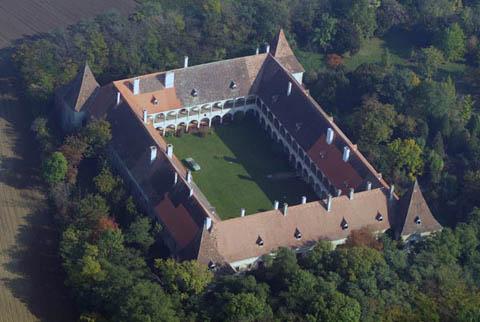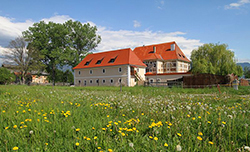Keresés
Austrian castles-ausztriai kastélyok
- Albertina palace
- Anif palace
- Ambras castle
- Aistersheim castle
- Asparn castle
- Belvedere palace
- Borostyánkő castlehotel
- Cumberland castle
- Deutschkreutz castle
- Dornach castle
- Draskovich castle, Güssing Németújvár
- Esterházy castle
- Eggenberg castle
- Eckartsau castle
- Farrach castle
- Glopper burgcastle
- Greillenstein castle
- Greinburg castle
- Halbturn castle
- Hellbrunni castle
- Herberstein castle
- Hohenems palota palace
- Hof castle
- Hofburg palace
- Hohenwerfen Burg
- Kaiservilla
- Kittsee castle
- Kreuzenstein burg
- Lamberg castle
- Laxenburg castle
- Loosdorf castle
- Leopoldskron castle
- Linzi castle
- Litzlberg castle
- Maria Loretto castle
- Mirabell castle
- Obermayerhofen castlehotel
- Ort castle
- Petronell castle
- Porcia castle
- Prugg castle
- Riegersburg castle
- Rochrau castle
- Rosenau castle
- Rosenegg castlehotel
- Rosenburg castle
- Rothschild castle
- Salaberg castle
- Schönbrunn palace
- Seggau castle
- Spielfield castle
- Starkenberg castle
- Rosegg castle
- Stainz castle
- St. Martin castle
- Tabor castle
- Tratzberg castle
- Toscana villacastle
- Tratzberg castle
- Wolfsberg castle
- Vasvörösvár castle
- Weitra castle
- Wiesberg castle
- Wolsberg castle
|
|
||||
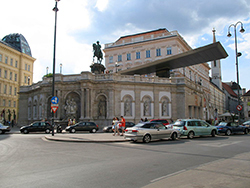 PHOTO:Andlinger |
|
|||
| The Albertina is a museum in the Innere Stadt (First District) of Vienna, Austria. The Albertina was erected on one of the last remaining sections of the fortifications of Vienna, the Augustian Bastion. Originally, the Hofbauamt (Court Construction Office), which had been built in the second half of the 17th century, stood in that location. In 1744 it was refurbished by the director of the Hofbauamt, Emanuel Teles Count Silva-Tarouca , to become his palace. It was therefore also known as Palais Taroucca. The building was later taken over by Duke Albert of Saxen-Teschen. He used it as his residence and later brought his graphics collection there from Brussels, where he had acted as the governor of the Habsburg Netherlands. He had the building extended by Louis Montoyer. Since then, the palace has immediately bordered the Hofburg. The collection was expanded by Albert's successors.
The collection was created by Duke Albert with the Genoese count Giacomo Durazzo (Austrian ambassador in Venice). In 1776 the count presented nearly 1,000 pieces of art to Duke Albert and his wife Maria Christina (Maria Theresia's daughter). Count Giacomo Durazzo – brother of Marcello Durazzo (Doge of Genoa) – "wanted to create a collection for posterity that served higher purposes than all others: education and the power of morality should distinguish his collection...." In the 1820s Archduke Charles, the foster son of Duke Albert and Maria Christina, initiated further modifications of the building by Joseph Kornhäusel, which affected mostly the interior decoration. After Archduke Charles, his son Archduke Albrecht and then Albrecht's nephew Archduke Friedrich, Duke of Teschen lived in the building. In March 1945 the Albertina was heavily damaged by Allied bomb attacks. The building was rebuilt in the years after the war and was completely refurbished and modernized from 1998 to 2003. Modifications of the exterior entrance sequence, including a signature roof by Hans Hollein were made until 2008, when also the graphics collection finally reopened. (Wikipédia) |
||||
| Bécs városközpontjában található az Albrecht főherceg palotájában (németül Palais Erzherzog Albrecht) berendezett Albertina múzeum. A grafikai gyűjteményt Albert Kázmér herceg létesítette az 1770-es években Pozsony várában, ahol 1765 és 1781 között lakott mint a királyi Magyarország kormányzója.
Az Albertina alapító oklevele 1776. július 4-én keletkezett. A dátum egybeesése az amerikai Függetlenségi Nyilatkozat aláírásának időpontjával puszta véletlen. A jelenlegi főhercegi palota átvétele (1795) óta található az épületben az Albertina-gyűjtemény. Ezt követően az épületet átépítették, így alkalmazkodva az új igényekhez. A jelentős gyűjteményt csak 1822-ben tették elérhetővé a nyilvánosság számára. Más gyűjteményekkel ellentétben, amelyeket a nemesség saját magának tartott fenn, a látogatásnak egyetlen feltétele az volt, hogy a látogatónak saját cipője legyen. Annak ellenére, hogy ezzel még mindig sokakat kizártak, a látogatói kör mégis észrevehetően kibővült. Albert herceg halála után a gyűjtemény és az épület örökösére, Károly főhercegre szállt, később Albrecht főherceg és Frigyes főherceg rendelkezett fölötte. Ebben az időben került sor a grafikai gyűjtemény további bővítésére. Az épületek és a gyűjtemény 1919 tavaszán a Habsburgoktól az Osztrák Köztársaság tulajdonába kerültek. 1920-ban az egykori császári udvari könyvtár (Kaiserliche Hofbibliothek) metszeteinek állományát egyesítették a gyűjteménnyel. Habár ekkorra a palota valamikori tulajdonosai minden vagyontárgyukat kiürítették az épületből, a gyűjtemények – az alapító oklevél szerint – mégis a palotához köthetők. Az „Albertina” nevet 1921 óta viseli az épület és a gyűjtemény. 1996-tól 2003-ig az Albertina el volt zárva a nyilvánosság elől, és teljes átalakításon ment keresztül. Ugyanebben az időszakban egy 3000 köbméteres raktárat hoztak létre az alagsorban, hogy ne rontsák el a városképet. A bejárat felújításával Hans Holleint bízták meg. Különösképpen az úgynevezett Soravia-szárny (Soravia-Wing) került a megosztott, többségében inkább kritikus véleményeket megfogalmazó médiafigyelem középpontjába. Egyúttal 2000. január 1-jén az Albertina szövetségi múzeumként jogi önállóságot kapott. A kiállításokat eredetileg már 2002-ben újra meg akarták nyitni, az átépítést azonban késleltette, hogy a helyszínen felfedeztek egy 130 sírhelyes római temetkezési helyet. A 2009. évi júniusi heves esőzések miatt víz szivárgott az alagsori raktárba. A biztonsági személyzet felfedezte a vízszivárgást, amely áramszünetet is okozott, emiatt megbénultak azok a robotgépek, amelyekkel a grafikákat tartó mappákat és kazettákat lehet mozgatni. Ahhoz, hogy a nagyobb károkat elkerüljék, 950 000 műtárgyat át kellett helyezni máshova. (Wikipédia) |
||||
|
Anif-kastély |
||||
Photo: Pixelcreatures |
|
|||
| Anif Palace (German: Schloss Anif), also known as the Water Palace Anif, is located beside an artificial pond in Anif on the southern edge of Salzburg, Austria.[1] The palace was once the seat of the bishops of Chiemsee, and then later was used as a court until the nineteenth century. It was remodeled between 1838 and 1848 in the neo-Gothic style. Anif is most famous for its use in several movies, including The Sound of Music and Frederick Forsyth's The Odessa File. Its origins cannot be exactly dated but there is a document from around 1520 showing that a palace called Oberweiher existing at this location. Its owner was the dominion directory bailiff Lienhart Praunecker. From 1530 the water palace is mentioned regularly as a fief given by the respective Archbishop of Salzburg. In this way it was given to the bishops of Chiemsee after a restoration by Johann Ernst von Thun in 1693; from then on, the bishops used it as a summer residence. When Salzburg fell to Austria in 1806, the palace and the pond came into public ownership. Although the palace was leased from that point on, the respective users did not undertake any rebuilding or restoring measures worth mentioning. This changed when the property was sold to Alois Count Arco-Stepperg in 1837. He rebuilt Anif Palace between 1838 and 1848 in new Gothic romanticizing style, and gave it its present-day look. Up to that time, the palace had simply consisted of a plain, four-story dwelling and a two-story connecting building to a chapel. After the death of the Count in 1891 the property fell to his nearest female relative, Sophie, who was married to the Count Ernst von Moy de Sons; the palace therefore ended up in the hands of his old French noble family. |
||||
|
A kastély története az 1520-as évektől kezdődik. Több tulajdonváltás után 1693-tól a salzburgi püspökség tulajdonába került, és nyári rezidenciaként használták. 1837- ben gróf Alois Arco-Stepperg vásárolta meg, aki 1838 és 1848 között fel is újítatta az épületet. A kastély ekkor nyeri el gótikus, romantikus stílusát, amely napjainkban is látható. Gróf Alois Arco-Stepperg lánya, Sophie beházasodott a bajor von Moy grófi családba, és a kastély Moy családi tulajdonba ment át. Napjainkban is a Moy család az épület birtokosa. A kastélytörténeti érdekesség, hogy 1918-ban a bajor király III. Ludwig keresett, és kapott menedéket a kastélyban, és a II. világháborúban anémet, és az amerikai hadsereg is igénybe vette a kastélyt. (1965- ös The sound of Music amerikai filmben is szerepel a kastély.) A kastély parkja kétszer egy évben látogatható: vallási körmenet Corpus Christi napján, és az éjszaka a December 8-án, amikor karácsonyi dalokat játszanak a kastély tornyából. (Wikipédia)
|
||||
|
Ambras-kastély |
||||
|
|
|
|||
|
Ambras Castle (German: Schloss Ambras) is a Renaissance castle and palace located in the hills above Innsbruck, Austria. Considered one of the most popular tourist attractions of the city, Ambras Castle was built in the sixteenth century on the spot of an earlier tenth-century castle, which became the seat of power for the Counts of Andechs. The cultural and historical importance of the castle is closely connected with Archduke Ferdinand II and served as his residence from 1563 to 1595. The Lower Castle contains two rooms of jousting armour from the late fifteenth century, including several suits made for Archduke Ferdinand himself. The Lower Castle's first floor contains a valuable art collection. Above the Lower Castle is the Spanish Hall (Spanische Saal), a notable example of German Renaissance architecture, which contains an intricate wood-inlay ceiling and walls adorned with 27 full-length portraits of the rulers of Tyrol. The Upper Castle contains an extensive portrait gallery featuring paintings of numerous members of the House of Habsburg. (Wikipédia) |
||||
| Az Ambras kastélyt – amely Innsbruck déli részén, egy dombon található – a XVI. században II. Ferdinánd pompázatos reneszánsz-rezidenciává alakíttatta át saját maga és felesége, Filippina Welser számára. A II. Ferdinánd főherceg által alapított gyönyörű ambrasi műgyűjtemények részeként megtekinthető többek között a főherceg kincseskamrája, fegyvertára és könyvgyűjteménye. A kastélyban drága, művészi bútorokkal berendezett előkelő lakótereket hoztak létre, ilyen például a festményekkel gazdagon díszített Spanyol terem is. A művészetekre iránt elkötelezett főherceg gyűjteményében találhatóak fegyverek, festmények, valamint a világ minden tájáról származó különböző ritka kiállítási darabok. Amióta a kastélyt 1880-ban múzeummá alakították át, nemcsak a lakótereket lehet megcsodálni, hanem a Habsburg-portrékból álló galériát, a kincseskamrát, valamint a páncélzattal és a lovagi tornákon használatos fegyverekkel teli fegyvertárat is. (austria.info) |
||||
|
Aistersheim-kastély |
||||
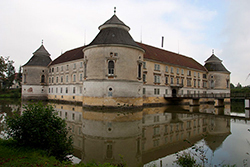 photo: Andlinger |
||||
| The Moated Castle of Aistersheim - A Renaissance Style Jewel. The Moated Castle of Aistersheim is noted for being about the most beautiful castle in all Upper Austria. | ||||
| Austria.Aistersheim vizi kastélya egy reneszánsz gyöngyszem. A legszebb kastélyként tartják számon Felső-Ausztriában. | ||||
|
Asparn-kastély |
||||
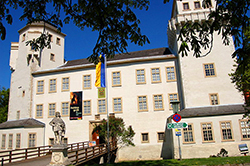 photo: Wolfgang Glock |
||||
| MAMUZ Schloss Asparn/Zaya gives visitors the opportunity to really experience 40,000 years of history. The exhibition invites visitors of all ages to experience history at interactive stations – seeing, for example, how tricky it is to make a copy of a longhouse in miniature form.
Just by looking at the setup and design of the building, visitors can already see that MAMUZ Schloss Asparn/Zaya contains a highly varied and fascinating history of the human race. The exhibition and the open-air site alone leave room for imagination. In addition, the museum also hosts events to give visitors the opportunity to celebrate alongside the Celts and Huns. With historical handcraft, hardworking people are asked to get an idea of how a bow is made or iron is smelted. (mamuz.a) |
||||
| Az Asparn/Zaya kastélyban őstörténeti kiállítás látható immár 44 éve. A látogatók élethű időutazáson keresztül találkozhatnak a szabadban is látható régészeti leletekkel . Ezenkívül bemutatásra kerül az ókori történelem és tárgyai Alsó-Ausztriából, beleértve a középkori régészeti leleteket is. Ez azt jelenti, hogy egészen a 400.000 évvel ezelőtti kőkorig visszamegy a kiállítás egészen a kora középkorig. | ||||
|
Belvedere-kastély |
||||
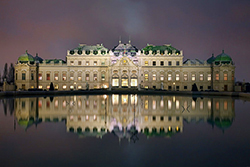 Photo: Julia W |
||||
| The Belvedere’s two magnificent palaces, the Upper and Lower Belvedere, were built in the 18th century as the summer residence for the important general Prince Eugene of Savoy (1663-1736). He chose one of the most outstanding Baroque architects Johann Lucas von Hildebrandt (1668-1745). The palaces with their extensive gardens are considered to be one of the world’s finest Baroque landmarks. Momentous events have taken place in the Upper Belvedere’s Marble Hall and from here there is a spectacular view of Vienna. (www.belvedere.at ) | ||||
| A Belvedere egyike a világ legszebb és legjelentősebb múzeumainak és Bécs legkimagaslóbb látnivalói közé tartozik. A barokk kastélyegyüttes olyan páratlan remekmű, mely egyesíti az építészet, szobrászművészet, festészet, kézműipar és barokk kertépítés, mint művészet, mesterműveit, valamint az osztrák történelem mérföld köveit, és több okból is meghódítja a látogatók szívét. A két Belvedere kastély, egykor a szőlőhegyek között a császárváros kapui előtt elterülve, építtetőjük, Savoyai Jenő herceg nyári rezidenciájaként szolgált. Jenő herceg (1663 - 1736), a leghíresebb osztrák hadvezér, számos győzelmével hozzájárult a Habsburg-ház gyors felemelkedéséhez. A kastélyegyüttes jeles építésze a császári udvar mérnöke, Johann Lukas von Hildebrandt (1668 – 1745) volt. A Felső-Belveder – készült 1717-től 1723-ig - dominánsan magaslik a dombtetőn, így nyújtva lenyűgöző kilátást Bécs városára. A Belvedere, mint név, azaz „szép kilátás“, Mária Terézia császárnéra vezethető vissza. Röviddel Jenő herceg halála után az ő tulajdonában volt a kastély. Azóta, hogy az ismert vedutafestő Bernar do Bellotto a 18. században nagyméretű festmény for- májában megörökítette a kilátást, általánosan a híres „Belvedere – kilátás“-ról beszélünk. A Felső-Belvedere tisztán reprezentatív célokból készült, amit a fényűzően felszerelt Márványterem és a drágán kialakított kastélykápolna még ma is egyértelműen tanúsít. Azt követően, hogy a császári gyűjtemény bemutatóhelyeként és Ferenc Ferdinánd trónörökös (elhunyt 1914-ben Szarajevóban) lakópalotájaként szolgált, a Felső-Belvedere még egyszer az osztrák történetírás központi színterévé vált. Az államszerződés 1955. május 15-i aláírásával, mely a kastély márványtermében történt, 10 évvel a II. világháború vége után Ausztria visszakapta teljes függetlenségét. A nagy kiterjedésű, lágyan lejtő park másik végében fekszik az 1714 és 1716 között felépített Alsó-Belvedere . A Jenő herceg privát lakópalotájaként készült kastélyban a barokk pompáról és életművészetről tanúskodnak a még fennmaradt dísztermek, úgymint a márványterem, márvány galéria és arany szoba, valamint a kastélyhoz tartozó narancsház és a fényűző lóistálló. A francia kertépítész Dominique Girard alakította ki a teraszformájú, gazdagon tagolt Kastélyparkot. . A barokk kert számos szökőkúttal, mitológiai szoborral, díszítő elemmel és virágágyással öleli körül és köti össze a két kastélyt. Ma a barokk kastélyegyütteshez tartozó összes épületet, úgy mint a Felső- és Alsó-Belvedere, a Narancsház és a Díszistálló, jelentős műalkotások bemutatására szentelik. Így a Felső-Belvedere-ben több mint 500 év művészettörténete, a középkortól egészen a 20. századig várja a látogatókat, míg az Alsó-Belvedere számos különböző kultúrkorszakot bemutató, kiváló kiállítás színhelyéül szolgál. (www.belvedere.at ) |
||||
|
Borostyánkő-várkastély |
||||
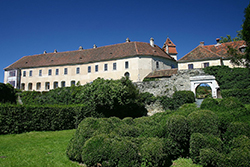 Photo: Steindy |
||||
|
In 860 the whole region was part of the archbishopric of Salzburg. Erimbert, a liege of the archbishopric, handed over the Pinka to one Jacobus. The village name Rettenbach was not mentioned yet, but the old Slavic name of the nearby hamlet Grodnau (meaning "the village belonging to the castle") is a sign of the existence of a nearby castle, identifiable with castle Bernstein. Since 1199 the castle was part of Hungary. It is not exactly known when the castle was handed over to Frederick II, Duke of Austria, and how long it was his property; but in 1236 Béla IV of Hungary conquered the castle. Some years later (in 1260) he gave it to count Henry II of Güssing. In 1336 the counts of Güssing and Bernstein were defeated by the Hungarian King Charles Robert of Anjou, and the castle of Bernstein became part of the Hungarian Kingdom. In 1388 the castle was given to the Kanizsai family. In 1482 it became property of Matthias Corvinus of Hungary for a short time; in 1487 Hans von Königsberg received the castle from Emperor Frederick III. In 1529 the Turks besieged the castle, but they were not able to capture it. Another unsuccessful siege by the Turks followed in 1532. On that occasion the ring of bastions was erected in order to change the castle into a refuge. In 1604 castle Bernstein was unsuccessfully besieged for weeks by a combined army consisting of Hungarians, Turks, and Tatars under the leadership of Stephen Bocskay. Due to an explosion of the gunpowder storeroom, in 1617 Ludwig Königsberg ordered the rebuilding of the Gothic inner part of the castle in Baroque style. The keep and towers were eliminated. A short time later (1644) Ehrenreich Christoph Königsberg sold the sovereignty and the castle to Count Ádám Batthyány. In 1864 Gustav Batthyány sell the castle to his manciple Edward O'Egan, whose heirs finally sold the castle to Eduard von Almásy. His family currently owns the castle. In 1953 a part of the castle was turned into a hotel. (Wiki) |
||||
| Itt született 1895-ben Almásy László neves Afrika-kutató. Életéről szól Az angol beteg (The English Patient) című hollywoodi – nem egészen hiteles – játékfilm. Itt temették el Egán Edét a családi sírboltban. Itt született 1873-ban Borostyánkői-Baldauf Mátyás, a pesti Mátyás-pince megalapítója. A települést 1249-ben említi először oklevél. Vára a gyepűk felszámolása után, a 13. század elején épült királyi várként. 1231-ben Frigyes osztrák herceg foglalta el, 1235-ben IV. Béla serege Geregye Pál országbíró vezetésével visszaszerezte. A tatárjárás után a Németújvári grófok tulajdonába került. 1285-ben Albert osztrák herceg súlyos vereséget szenvedett a vár alatt, négy évvel később azonban sikerült bevennie. A magyar királyok és az osztrák hercegek között váltakozó szerencsével folyt a harc a vár birtoklásáért. A Kanizsaiak 1388-ban Zsigmond királytól zálogba kapták a borostyánkői birtokot, melyet ekkor „Porostyán” alakban említenek. 1392-ben a tulajdonjogát is megszerezték. 1491-től 1647-ig Ausztriához tartozott, 1602-ben vásártartási jogot kapott. A várat 1532-ben a török ostromolta, 1536-ban felrobbant a lőportornya. Hatalmas bástyái 1546 és 1590 között készültek. 1617-ben ismét a lőportorony felrobbanása rongálta meg. 1625-ben újjáépítették. 1636 és 1864 között a Batthyányaké, ez idő alatt nyerte el mai formáját. Batthyány Gusztáv 1865-ben az angol Edward Egan-nak adta el birtokot, akinek az örökösétől 1892-ben vásárolta meg az Almásy család a várat. (Wiki) |
||||
|
Cumberland-kastély |
||||
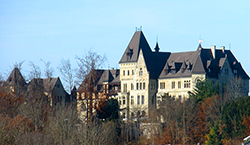 Photo: Pepito Tey |
||||
| The beautiful Cumberland Castle, which is built in the Tudor style, situated on a small hill, adorned with a park, for walks inviting promenade, above the natural gem Krottensee. It was built by order of Duke Ernst August of Cumberland in 1882 until 1886. Currently, there are social institutions in the castle. | ||||
| A kastély az angliai uralkodó 5. György király rokonságába tartozó, Alexandra hercegnő tulajdonában volt. A kastély 1940 és 47 között katonai kórházként is szolgált, majd sokáig a TBC-s betegeket is gyógyították itt. Napjainkban szociális és beteg otthonként működik. | ||||
| Deutschkreutz-kastély | ||||
|
|
||||
| Castle Deutschkreutz was built in 1625 by Graf Paul Nàdàsdy and is located in the Burgenland 5 km from the Hungarian border.
It has four wings, with two floors around a rectangle shaped court and four low corner towers. The castle also used to be surrounded by a moat. One of the towers is home to a beautiful chapel. Some of the impressive ornaments are still there today, and give an idea of the great architecture of the 17th century. There used to be an imposing festival hall in front of the castle, but it had to be removed in 1952 because of dilapidation. |
||||
|
Kastélyát 1492-ben a Kanizsaiak építették lovagvárnak, 1560-ban és 1625-ben a Nádasdyak átépítették. Nádasdy Ferenc lefejezése után 1676-ban a kastély az Esterházy család kezébe került és ezáltal egyre jobban elvesztette a kulturális jelentőségét, úgy hogy gyakorlatilag csak egy gazdasági udvar szerepét töltötte be. A korábban egy vizesárokkal körülvett reneszánsz kastély két szintjét egy négyszögletű belső árkádokkal épített négyszárnyú együttes képezi. A négy alacsony saroktorony, melyeknek egyikében a kastély kápolnája kapott helyet, előre ugranak az egykori vizesárokba. Az épület 1945-ben súlyos károkat szenvedett. 1952-ben egy részét veszélyessége miatt le kellett bontani. Figyelemreméltóak a kiváló észak- olaszországi mesterek kezenyomát viselő stukkódíszek. 1971-óta kulturális örökség védelem alatt áll. |
||||
|
Dornach-kastély |
||||
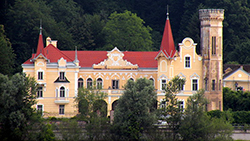 Photo: Pfeifferfranz |
||||
| In 1455 the manor was mentioned in the documents. In 1890, became the property of Maria Theresia Princess of Thurn und Taxis. Then rebuilt. In 2003, the Gschösser and Ebenbichler (Tyrol), the family purchased and renovated the castle. Lived in the castle in 1893, the Swedish poet August Strindberg with his family. The castle architecture in the Neo-Baroque and neo-Renaissance style mixed units. | ||||
|
1455-ben már emítik az okíratok a kastélyt. 1890-ben Maria Theresia Thurn und Taxis hercegnőjének tulajdonába került. Ekkor újjáépítették. 2003-ban a Gschösser és Ebenbichler (tiroli), család vásárolta meg,és felújították a kastélyt. A kastélyban élt 1893-ban, a svéd költő August Strindberg a családjával. A kastély építészetében a neobarokk, és a neoreneszánsz stílusjegyek keverednek. |
||||
|
Draskovics-kastély |
||||
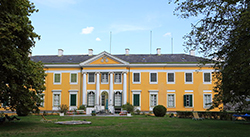 Photo: Bwag |
||||
| The castle was used as a summer residence of the Batthyány family. In 1804, the castle was built in the neoclassical Draskovich style. chapel is Gothic triptych made in 1469. Currently not open. Nearby is the landscape of outstanding castle. The Castle Museum exhibition showing the history of 400 years. |
||||
|
A kastélyt a Batthyány család nyári rezidenciaként használta. A Draskovich-kastély 1804-ben épült klasszicista stílusban, kápolnájában 1469-ben készített gótikus szárnyasoltár áll. Jelenleg magántulajodban van, nem látogatható. A kastélyhoz közel található a tájból kiemelkedő vulkanikus eredetű hegyen álló vár. A vármúzeumban 400 év történetét bemutató kiállítás látható. (Wikipédia) |
||||
|
Esterházy-kastély |
||||
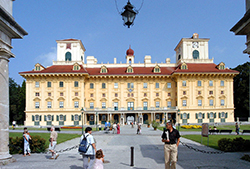 Photo: Johann Jaritz |
|
|||
|
Esterházy Palace in Eisenstadt is one of the most beautiful baroque palaces in Austria and presents a fascinating view of the resplendent life once lived at the court of the Princes Esterházy. But the palace is still the hub of the cultural scene today and regularly provides the picturesque backdrop for festivities and social events. (http://esterhazy.at/en) The most important seat of the Esterházys was Eisenstadt (Hungarian: Kismarton), since the heads of the family chose to make a castle in this tiny village their primary residence. A fortified stronghold had been built there in the 14th century; after the Esterházys acquired it they rebuilt it 1663–1672 to what is now the princely Schloss Esterházy. Their practical reason for choosing to create and maintain the princely court at Eisenstadt may have been that while the region was in Hungary, it had been mainly settled by Germans, and was situated rather close to the Habsburgs' Imperial residence, Vienna. (The region remained part of Hungary until 1921, when it was handed over to Austria according to the Treaty of Saint-Germain, 1919, and the Treaty of Trianon, 1920.) (Wikipédia) |
||||
| A barokk Esterházy-kastély az 1660-as évektől 1683-ig épült. Teljesen sohasem fejezték be, mert az eredeti tervrajz szerint még két szárnynak kellett volna hozzá csatlakoznia. Főhomlokzatát a magyar vezérek márványba vésett mellképei díszítik. A kastéllyal szemben, a tér tulsó oldalán vannak az istállók, két nagy épület, köröskörül toscanai oszlopokkal díszítve, belül pazarul berendezve. A kastély mögötti park fejedelmi üveg- és pálmaházai már abban a korban is ritkaság számba mentek. A hegyi tó mellett mesterséges halmon jón oszloprenddel övezett és kupolával födött kis kerek építmény, a Leopoldina-csarnok emelkedik. Belseje egészen egyszerű, közepét a bejárattal szemben carrarai márványból faragott szobor foglalja el, mely Esterházy Leopoldina hercegnőt görögös öltözékben, ülő helyzetben ábrázolja. A szobor Antonio Canova itáliai szobrászművész alkotása. A kastélyban levő ritkaságok közül Haydn zongoráját érdemes kiemelni. A kastély tornyában van az akkori Magyarország ország legnagyobb harangja, a 175 mázsás harangot még a fraknói nagyharangból öntötték. Roppant gazdag az Esterházyak levéltára is, csak Árpád-kori oklevélből mintegy 300-at tartanak nyilván. (Wikipédia) | ||||
|
|
||||
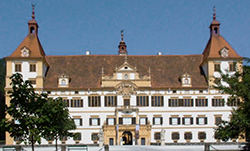 |
||||
| Graz városának egyik legnevezetesebb műemléke, három emeletes gyönyörű barokk reprezentációs épület fényűzően berendezett termekkel. Az Unesco 2010-től nyilvánította a világörökség részévé. 1623–ban Hans Ulrich von Eggenberg birodalmi herceg építtette Giovanni Pietro de Pomis építésszel barokk stílusban. Az Eggenberg családi ág nem folytatódott, ezért Leopold Herberstein lett az új tulajdonos, aki átépítette a kastélyt. Ebben az időszakban alakították ki a barokk udvart is. Napjainkban az Universal Joanneum Múzeum birtokában van az épület. (Wiki) | ||||
| Architecture Eggenberg Palace is a unique synthesis of the arts dating back to the early Baroque period where architecture and design combine to create a complex symbolist representation of the universe, the cosmos of an educated statesman. The residence of Imperial Governor Hans Ulrich von Eggenberg is political architecture established to express the powerful legitimation of the rule of a family. In 1625 Prince Hans Ulrich von Eggenberg selected the exact same place chosen as the site of the family seat by his great-grandfather, Balthasar Eggenberger, one and a half centuries earlier for the construction of the new residence. Parts of the previous medieval castle were, however, kept and incorporated into the newly constructed Baroque four-winged palace. The central tower with its gothic chapel even became the very core of the new palace. Traces of this medieval structure are still being discovered today. (http://www.museum-joanneum.at/en) |
||||
|
|
||||
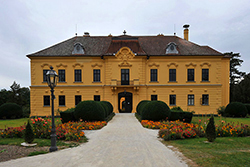 Photo: Ailura |
||||
| The first written mention of Eckartsau can be found in the 11th Century in a deed of gift to the monastery of Klosterneuburg. At the time, Eckartsau was a four-sided castle surrounded by a moat.
The Manor of Eckartsauer increased its possessions and acquired land to the east and west, as well as castles, markets and rights. In the 16th and 17th century the Lords of Eckertsau changed frequently. Today's magnificent appearance of the castle is mainly due to Count Franz Ferdinand von Kinsky. The Bohemian chancellor bought the property in 1720 together with the Manor of Eckartsau and had the medieval fortress converted and expanded into a Baroque hunting lodge. First-class artists such as Fischer von Erlach, Daniel Gran and Lorenzo Mattielli were instrumental in the extensive redesign. In 1760, Franz Stephan von Lothringen, the husband of Empress Maria Theresa, purchased the castle. Among the most prominent later owners were Archduke Franz Ferdinand and the last Emperor and Empress of Austria Karl I and Zita, who spent their last days in Austria in the castle before their departure into exile. After 1945, Österreichische Bundesforste took over the management of Schloss Eckartsau. They have worked in the last few decades on the restoration of the castle which was to some extent in a dilapidated state, so that it now shines again in its old glory. (schlosseckartsau.at) |
||||
|
Az első írásos emlék 1180-ból maradt fenn, amikor a jelenlegi kastély még négyszögletes, dupla vizesárokkal körülvett védvár volt. A kastély jelenlegi impozáns formáját Franz Ferdinand von Kinsky gróf idejében kapta. A cseh udvari kancellár 1720-ban vásárolta meg a birtokot, és építtette át, valamint bővíttette ki a középkori védelmi építményt barokk vadászkastéllyá. A költséges |
||||
|
|
||||
|
|
||||
| The castle was built between 1670 and 1680 Baron Friedrich Carl Renaissance style. Special facade of the castle and the surrounding coal mines silver mining slag material built up. One of the prides of the interior of the baroque chapel. The building was reconstructed in 1989. | ||||
|
A kastélyt 1670-és 1680 között építtette báró Carl Friedrich reneszánsz stílusban. A kastély különleges homlokzatát a környező szén és ezüstbányák hulladék salakanyagát felhasználva alakították ki . A belső tér egyik büszkesége a barokk kápolna, amelyet szintén a kornak megfelelően állítottak helyre, az 1989-es rekonstrukció során. |
||||
|
Glopper-várkastély |
||||
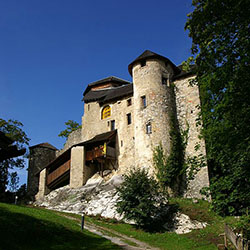 Photo: Böhringer Friedrich |
||||
| Neu-Ems Castle (German: Burg Neu-Ems or Schloss Glopper) is a medieval castle in Hohenems in the province of Vorarlberg, Austria. It was the fortification of the nobility Herren von Ems (Lords of Ems). Approved by Emperor Louis IV the Bavarian, Ritter Ulrich I. von Ems (Knight Ulrich I of Ems) in 1343 built a new castle to have a comfortable home for his large family in dangerous times. He placed it near his fortress Alt-Ems on a hilltop. During the Appenzell Wars in 1407 the castle was destroyed and rebuilt shortly afterwards. In 1603 a chapel was assembled to the ground floor. Except two lancet windows in the northern wall there is nothing left over of it today. Since 1835 the former winged altar of this chapel is exhibited in the Tyrolean State Museum in Innsbruck. Since 1843 the stronghold is privately owned by the family Waldburg-Zeil. (Wikipédia) |
||||
| Neu-Ems-várkastélya középkorból származik, és a Vorarlbergi Hohenems tartományban található, Ausztriában. A várat I. Ulrich lovag építtette 1343-ban IV. Lajos bajor császár engedélyével. 1407-ben az Appenzell háborúban súlyosan megsérült várat újjáépítették. A várkastély kápolnájának legértékesebb alkotásai a "Krisztus születése" főoldal oltárkép, és a "napkeleti bölcsek imádása " jelenleg az innsbrucki múzeumban található. 1765-ben a Mária Terézia tulajdonába került a várkastély, majd, 1834 után a Hohenems család tulajdonában van az épület. ( A kis Vorarlberg Castle könyv Franz Josef Huber) | ||||
|
Greillenstein-kastély |
||||
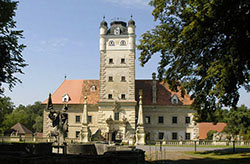 Photo: Manfred Kuzel |
||||
| The Renaissance castle of Greillenstein was built in the 16th century and for a long time was used for administrative purposes. It has survived the course of the centuries almost unscathed and is now privately owned. Greillenstein Castle has a lot to offer: Renaissance baths, a dungeon, a park and the dwarves' garden with an interesting collection of sandstone dwarves. The famous courtroom, chapel, library and Turks' Hall can only be seen as part of a guided tour. The spookier side of castle life can be experienced on one of the candlelit evening ghost tours. (waldviertel.at) | ||||
|
A mai kastély helyén a középkorban egy kis erődítmény volt, amit Kuefstein leromboltatott, hogy a helyére kastélyt építtessen. A kastély 1570-től 1590-ig épült reneszánsz stílusban, és többnyire napjainkig változatlan maradt. |
||||
| Greinburg-kastély | ||||
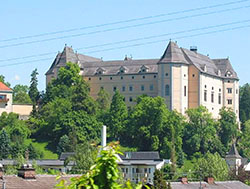 Photo: by UserAndrei Stroe |
||||
| 1488-1493 Under the later Reichsfreiherr (Baron whose title has been confirmed upon him by the German king) of Stettenberg and Earls of Hardegg, Heinrich and Siegmund Prüschenk, the Castle of Greinburg was erected between 1488 and 1493 as one of the first castles in the German- speaking region. 1533 In 1533 the Imperial Counsel, Burgvogt (Governor of a castle) of Enns and Landvogt (Governor of a territory) of Swabia, Johann Leble (Löbl), acquired the Castle. Under Leble (Löbl) the building received most of its present- day form. In 1621 the Castle of Greinburg was sold to the Earl Leonhard Helfrich of Meggau, who carried out basic changes. A three storeyed, columned arcade became the main feature for the appearance of the inner courtyard. Furthermore, under Meggau the Sala terrena (so-called stone theatre) was installed. In 1625 the "Rittersaal", the Hall of Knights, and an adjoining chapel in the south west tower were redecorated. Anna of Meggau brought Castle and dominion of Grein into her marriage with her husband, Earl Ludwig Sigmund of Dietrichstein. 1700 Since 1700 the owner of Greinburg was Earl Oktavian Karl of Carioni, who sold the Castle to Franz Ferdinand of Salburg and Prandegg in 1709. In 1810 the family of Dietrichstein became once again the owners of Greinburg, however they sold the estate in 1811 to Josef Fink, the Mayor of Hainburg. Large coat of arms of the House of Saxe-Coburg and Gotha since 1822 The Dukes of Saxe-Coburg and Gotha have been owners of the Castle only since 1822. In 1822 Duke Ernst III of Saxe-Coburg-Saalfeld, who in 1826 became Ernst I. of Saxe-Coburg and Gotha, also acquired the dominions of Aich, Prandegg, Kreutzen, Ruttenstein and Zollhof together with the dominion of Grein. The son of Ernst I., Herzog Ernst II., was proprietor of the Castle of Greinburg from 1844 until 1893. After his death in 1893 Queen Victoria of England was also briefly the owner of Greinburg. Until this day the Castle has been inhabited by the ducal family. The Castle of Greinburg was chosen, for instance, by the Duchess Viktoria Adelheid as her summer residence. Her son, Prince Friedrich Josias, lived there permanently until his death. The building, which comprises four wings, houses the Coburg Rooms, which are the official rooms of the ducal family, as well as the Upper Austrian shipping museum. (schloss-greinburg.at) |
||||
| 1488 és 1493 között épült a greinburgi kastély, amely német nyelvterületen az első kastélyok egyike. 1533-ban a császári jogtanácsos Johann Leble, megszerezte a kastély. Később a 1621-ben a vár Earl Leonhard Helfrich a Meggau tulajdonába került, aki alapvető változásokat végeztett. Három emeletes, oszlopos árkád lett a belső udvarban kialakítva . Továbbá ki lett építve a Meggau a Sala Terrena (úgynevezett kőszínház. A lovagterem 1625-ben és a kápolna, a dél-nyugati torony is fel lett újjítva. 1700-ban Greinburg tulajdonosa Earl Oktavian Karl a Carioni lett, aki eladta a kastélyt Ferenc Ferdinándnak 1709-ben. 1810-ben a Dietrichstein család lett ismét a tulajdonosa a Greinburg várának, de eladták a birtokot 1811-ben Josef Fink, Hainburg polgármesterének. 1822 után a vár Saxe-Coburg és Gotha hercegének tulajdonába ment át. 1826-ban I. Ernst Saxe-Coburg és Gotha lett a birtokosa a kastélynak, aki uralkodott Aich , Prandegg, Kreutzen, Ruttenstein és Zollhof és Grein felett is. A fia, I. Ernst, és II. Ernst , voltak a tulajdonosai a kastélynak egészen 1893-ig. 1893-ban Viktória királynő, Anglia uralkodója lett a tulajdonosa Greinburg várának rövid ideig. A várat napjainkban is a hercegi család lakja. A Greinburgi vár, Viktoria Adelheid hercegnő nyári rezidenciája is volt. Fia, Prince Friedrich Josias, a kastélyban élt haláláig. Az épület, amely négy szárnya ad otthont a Coburg hercegi családnak, valamint a felső-ausztriai hajózási múzeumnak. |
||||
|
Halbturn-kastély |
||||
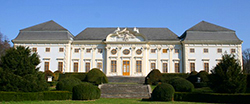 |
||||
| Halbturn (Hungarian: Féltorony) is a town in the district of Neusiedl am See in the Austrian state of Burgenland. It borders Hungary to the east and is near Andau, Gols, and Mönchof. Halbturn Castle was built between 1701 and 1711 by Johann Lukas von Hildebrandt as a hunting lodge for Charles VI, Holy Roman Emperor. His daughter, Empress Maria Theresa, had it enlarged and gave it to her daughter Maria Christina, Duchess of Teschen. In 1955 it was inherited by Baron Paul Waldbott von Bassenheim, a Hapsburg matrilineal descendant. In 2008 it passed to his nephew, Count Markus Königsegg. (Wiki) | ||||
| A lerombolt vadászkastély helyén 1711-ben épült Johann Lukas von Hildebrandt tervei szerint későbarokk (más néven copf, vagy klasszicizáló későbarokk) stílusban. A kastély a barokk világi építszet egyik kiemelkedő alkotása. Mária Terézia a Habsburg–Lotaringiai család magánrezidenciájává tette. 1949-ben leégett, csak a középső terem maradt sértetlen, melyet helyreállítottak. Ma Paul Waldbott-Bassenheim bárónak, a császári család egyik leszármazottjának magánbirtoka. A kastély a nyilvánosság előtt is nyitva áll, kiállításokat, koncerteket tartanak benne, egy része pedig múzeumként szolgál. A volt gazdasági udvarból nyíló barátok pincéje vendéglátóhelyként működik. Ugyanitt panzió is található. (Wiki) |
||||
|
Hellbrunni-kastély |
||||
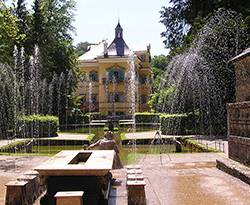 Photo: Matilda |
||||
|
Hellbrunn Palace (German: Schloss Hellbrunn) is an early Baroque villa of palatial size, near Morzg, a southern district of the city of Salzburg, Austria. It was built in 1613-19 by Markus Sittikus von Hohenems, Prince-Archbishop of Salzburg, and named for the "clear spring" that supplied it. Hellbrunn was only meant for use as a day residence in summer, as the Archbishop usually returned to Salzburg in the evening, therefore, there is no bedroom in Hellbrunn. The schloss is also famous for its jeux d'eau ("watergames") in the grounds, which are a popular tourist attraction in the summer months. These games were conceived by Markus Sittikus, a man with a keen sense of humour, as a series of practical jokes to be performed on guests. Notable features include stone seats around a stone dining table through which a water conduit sprays water into the seat of the guests when the mechanism is activated, and hidden fountains that surprise and spray guests while they take part on the tour. Other features are a mechanical, water-operated and music-playing theatre built in 1750 showing various professions at work, a grotto and a crown being pushed up and down by a jet of water, symbolising the rise and fall of power. At all of these games there is always a spot which is never wet: that where the Archbishop stood or sat, to which there is no water conduit and which is today occupied by the tour guide. Hellbrunn stands in a large park with a neighboring zoo, a stone theater and a small building known as the Monatschlössl, or the "little month-palace",as it was built during the period of one month after a visitor commented to Sittikus that a building on the hill would improve the view from one of the schloss' windows. The archbishop took heed of his advice, and when the visitor returned a month later the Monatschlössl was built. It now houses the ethnographical section of the Carolina Augusteum Museum of Salzburg. The Castle of Hellbrunn Coin |
||||
| Markus Sittikus von Hohenems választották meg 1612-ben a salzburgi érseknek. 1613-1615-tól megbízást adott Salzburg déli részén új székhely kialakítására. Az épület késő gótikus stílusban olasz mintára épült a déli külvárosában villa suburbana, vagyis egyfajta nyári rezidencia céljára. Az építész Santino Solari volt, aki a salzburgi székesegyházon is dolgozott. A bálterem falai és a boltíves mennyezete allegorikus jelenetekkel - feltehetően Arsenio Mascagni munkája - gazdagon festett. Figyelemre méltó továbbá az un. Nyolcszög szoba, Halterem, Madár szoba és sarok. A zárt udvar melléképületei szimmetrikusan vannak elrendezve. A kastélyt keletről fasorral kísért úttengelyére van szervezték, majd a kapun belül két oldalról fallal kísérve vezeti a tekintetet a központi udvarra. A kiterjedt parkot 1730 körül átalakították, Franz Anton Danreiter udvari kertfelügyelő tervei alapján és a kor ízléséhez igazították. A parkban található isten- és hősi alakokat ábrázoló szobrok a 17. század elejéről származnak.
A valamikori hellbrunni kőfejtőt Markus Sittikus színházzá alakíttatta, így jött létre a "Steintheater" (Kőszínház), Európa első szabadtéri színpada. _Ugyancsak Hellbrunnban áll a Waldems Kastély, amelyet a köznyelv Monatsschlößchen néven is emleget, mert rendkívül rövid idő, alig néhány hónap leforgása alatt épült 1615-ben Markus Sittikus érsek megrendelésére. Ma a salzburgi Carolino Augusteum Néprajzi Múzeumnak ad otthont. A hellbrunni kastélypark fölött, idilli környezetben díszelgő kis kastély termeiben népszokások és népi játékok elevenednek meg, a népi lakáskultúra, a népi gyógyászat és a környék jellegzetes népviseleteinek válogatott darabjai társaságában._ Hellbrunn kastélyát végül igen ritkán használták érseki székhelyként. A díszes termek és a különleges vízi játékokkal tarkított, varázslatos kert a kezdetektől fogva ünnepségek, előadások, kulturális rendezvények helyszínéül szolgáltak. Valaha kirándulni, vadászatokra és fényes fogadásokra érkeztek a vendégek Hellbrunnba – ma leginkább konferenciákra, szemináriumokra és elegáns társasági eseményekre. A kastély mindenféle nemzetközi rendezvények kedvelt helyszíne. A kastély környezet A kastélyon kívül sok munkát fektettek a környező táji kapcsolat kialakítására is. Hellbrunner Allee-t Markus Sittikus 1614/1615-ben hozta létre késő reneszánsz stílusban. Az úttal a célja a hercegi kert és táj Freisaal-kastély felé való kiterjesztése volt, kifejezve az ifjú herceg abszolút hatalmát. A Lindenalle (ma Fürstenweg) a Salzach folyóig nyújtja a kastélykertet, amelynek tengelyében áll a főépület áll. A Diána szobortól induló allé szintén egy fontos tengely, amelyre szimmetrikus a halakkal gazdagított nagymedence, majd áthalad a vadászkerten, és távolban a Salzach folyó túlpartján magasodó Goldenstein-kastélyt célozza meg. |
||||
|
Herberstein-kastély |
||||
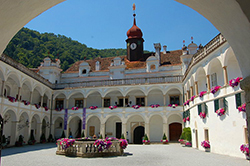 Photo: Wolfgang Glock |
||||
|
Herberstein Castle sits on a boulder in the Feistritz ravine and thus is not accessible from 3 sides. At the same time, the castle is not visible from out of the ravine and was thus naturally protected from attackers. |
||||
| A több mint 700 éves stájer kastély három stílustörténeti korszak – a gótika, a reneszánsz és a barokk hatása alatt formálódott. A kastély kertépítesze is jelentős. A hangulatok kertje mellett van egy zöld, fehér, sárga és kék kert is, ezeket pedig délelőtti, déli, délutáni és esti kertek egészítik ki. A kastélyban található egy állatkert is többek között gepárdokkal. A kínálatot két múzeum teszi teljessé: a napjaink egyik legjelentősebb osztrák művészének, Bruno Gironcoli szobrait kiállító múzeum illetve a nemzetközi művészeket bemutató Kunsthaus (Művészet háza). ( Austriainfo) |
||||
|
Hof-kastély |
||||
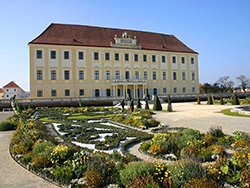 Photo: Peter Knorr |
||||
| Schloss Hof is a palace located in Austria near the border of Slovakia. It once belonged to Prince Eugene of Savoy who purchased it late in his life in 1726, He had it enlarged in the Baroque style by the architect Johann Lukas von Hildebrandt in 1729, and used it as an elaborate hunting lodge. He left it to a niece in his will, and it was later purchased by Empress Maria Theresa of Austria and became part of the imperial estates.
The Castle of Schloss Hof is so popular and famous that it was the main motive of one of the most famous silver collectors coins: the The Castle of Schlosshof coin. This coin was issued honouring the castle with the obverse side showing a view of the castle from the terraced garden side. (Wiki) |
||||
| Alsó-Ausztria keleti részén több mint 50 hektáron terül el a Hofi kastély. A főúri lakóépületből, a művészien kialakított teraszos kertből és az idilli majorságból álló pazar épületegyüttest a kései 1720-as években Savoyai Jenő herceg reprezentatív vidéki és vadászszékhelyeként létesítették. Johann Lucas von Hildebrandt építész korlátok nélkül mindenből a legjobbat választhatta – végül is megbízója nem csak az egyik legsikeresebb hadvezér volt, hanem korának egyik legvagyonosabb embere. Több száz munkást, napszámost, mesterembert és kertészt fogadtak fel, hogy több éves szakadatlan munkával megvalósítsák Hildebrandt terveit. Amikor 1730 körül nagyjából lezárultak a munkálatok, az európai barokk egyik leglenyűgözőbb mesterműve konkrét alakot öltött. (schlosshof.at)
Átfogó felújítási munkálatok után a teraszokon virágágyások, függőfolyosók és pompás szökőkutak várják a látogatókat. A Schloss Hof minden évszakban más színekkel és növényekkel gyönyörködtet. A művészien megalkotott virágágyások tavasszal tulipánokkal, nárciszokkal, ibolyákkal és császárkoronákkal varázsolják el a látogatókat. Nem kevésbé szemet gyönyörködtető az orangerie: jácintok, krókuszok és császárkoronák képezik az impozáns élő szőnyeget. Nyáron a rózsáké, petúniáké, napraforgóké a főszerep a barokk kertben, melyet végül ősszel a rikítóan piros rózsák és narancsosan nyíló dáliák foglalnak el. |
||||
|
Hohenems-kastély és palota |
||||
 |
||||
| The palace of Hohenems is the one the most important renaissance building in West Austria. It was designed by Martino Longhi. Presently it is runing an exclusive restaurant and event locale. |
||||
| A Hohenems palota legjelentősebb reneszánsz épülete Nyugat-Ausztriában. Tervezte Martino Longhi. Jelenleg eszkluzív étterem és rendezvény helyszín. (Wiki) | ||||
|
Hofburg-császári palota |
||||
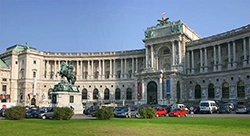 Photo: Peter Gerstbach national library, part of the Hofburg |
|
|||
| Hofburg Palace is a palace located in Vienna, Austria, that has housed some of the most powerful people in European and Austrian history, including the Habsburg dynasty, rulers of the Austro-Hungarian Empire. It currently serves as the official residence of the President of Austria. It was the Habsburgs' principal winter residence, as the Schönbrunn Palace was their preferred summer residence.
The Hofburg area has been the documented seat of government since 1279 for various empires and republics. The Hofburg has been expanded over the centuries to include various residences (with the Amalienburg), the Imperial Chapel (Hofkapelle or Burgkapelle), the Naturhistorisches Museum and Kunsthistorisches Museum, the Austrian National Library (Hofbibliothek), the Imperial Treasury (Schatzkammer), the Burgtheater, the Spanish Riding School (Hofreitschule), the Imperial Horse Stables (Stallburg and Hofstallungen), and the Hofburg Congress Center. The Hofburg faces the Heldenplatz ordered under the reign of Emperor Francis Joseph, as part of what was to become a Kaiserforum that was never completed. Numerous architects have executed work at the Hofburg as it expanded, notably the Italian architect-engineer Filiberto Luchese (the Leopoldischiner Trakt), Lodovico Burnacini and Martino and Domenico Carlone, the Baroque architects Lukas von Hildebrandt and Joseph Emanuel Fischer von Erlach (the Reichschancelry Wing and the Winter Riding School), Johann Fischer von Erlach (the library), and the architects of the grandiose Neue Burg built between 1881 and 1913. (Wikipédia) |
||||
| A Hofburg Bécsben a Heldenplatzon álló épületegyüttes, az egykori császári palota. Egyszerűen csak Burgnak szokás nevezni. Monumentális, tekintélyt sugárzó épületegyüttese évszázadok óta az osztrák főváros egyik dísze.
A magját alkotó középkori várat a 13. században építették, és 1283, vagyis I. Albert német király regnálása óta ez számított az uralkodók rezidenciájának. Szinte minden király és császár épített hozzá, így szinte már valódi város a városban, 240 000 ezer négyzetméteren terül el Bécs központjában. A régi vár idővel svájci szárnnyá változott, ezt a nevét a benne lakó svájci gárdistákról kapta, akik a palotaőrséget alkották. Ma itt találhatók a koronázási jelvények. A 16. században épült a Stallburg, amely a 18. század óta a királyi istállóknak is helyet biztosít, illetve szintén 16. századi Amalienburg, ami eredetileg különálló épület volt, de I. Lipót császár összekötötte azt a svájci szárnnyal. Az újonnan létrejött Lipót-szárnyba azután Mária Terézia császárné költözött be, ma pedig ez az osztrák államfő székhelye. 1452-től a Hofburg volt a Habsburg Birodalom uralkodóinak, az osztrák uralkodó főhercegeknek, és a Habsburg-családból választott német-római császároknak székhelye, 1806–1918 között itt volt az osztrák császárok lakóhelye. Ma a Nemzeti Könyvtár és a Sissi Múzeum is itt kap helyet, valamint a csodálatos Szent Mihály-szárny, amelynek 50 méter magas kupolája az épület leglátványosabb eleme. A sok helyen átjárható épületegyüttesben 18 épületrész, 54 lépcsőház, 26 folyosó 19 udvar és 2600 helyiség található, a komplexumban 5 000 ember él és dolgozik. („A jó császár tulajdonképpen átjáróházban lakik” – mondta egy alkalommal I. Ferenc József.) (Wikipédia)
|
||||
|
Hohenwerfen burg-várkastély |
||||
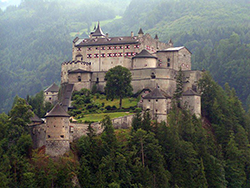 Photo: Memorator |
||||
| Hohenwerfen Castle (German: Burg Hohenwerfen) stands high above the Austrian town of Werfen in the Salzach valley, approximately 40 km (25 mi) south of Salzburg. The castle is surrounded by the Berchtesgaden Alps and the adjacent Tennengebirge mountain range. The fortification is a "sister" of Hohensalzburg Castle both dated from the 11th century. History The former fortification was built between 1075 and 1078 during the Imperial Investiture Controversy by the order of Archbishop Gebhard of Salzburg as a strategic bulwark atop a 155 m (509 ft) high rock. Gebhard, an ally of Pope Gregory VII and antiking Rudolf of Rheinfelden, had three major castles extended to secure the Salzburg archbishopric against the forces of King Henry IV: Hohenwerfen, Hohensalzburg and Petersberg Castle at Friesach in Carinthia. Nevertheless Gebhard was expelled in 1077 and could not return to Salzburg until 1086, only to die at Hohenwerfen two years later. In the following centuries Hohenwerfen served Salzburg's rulers, the prince-archbishops, not only as a military base but also as a residence and hunting retreat. The fortress was extended in the 12th century and to a lesser extent again in the 16th century during the German Peasants' War, when in 1525 and 1526 riotous farmers and miners from the south of Salzburg moved towards the city, laying fire and severely damaging the castle. In 1931 the fortress, since 1898 owned by Archduke Eugen of Austria was again damaged by a fire and, though largely restored, finally had to be sold to the Salzburg Reichsgau administration in 1938. After World War II it was used as a training camp by the Austrian Gendarmerie (rural police) until 1987. |
||||
|
-Ausztria legnagyobb, épségben megmaradt középkori vára. 1077 –ben kezdték el építeni, 1122-ben tovább bővítették. A mai formáját, 1563-1580 között nyerte el. Az erődítmény különlegesen látványos védelmi rendszerrel rendelkezik.- Hohenwerfen kastélya magasan emelkedik Werfen városa fölé a Salzach völgyében kb 40 km-re délre Salzburgtól. Az erődítményt a Hohensalzburg kastély "nővérének" is nevezik. Mindkét épület a 11. sz.-ban épült. A hajdani kastélyt 1075 és 1078 között emelték Gebhard salzburgi érsek megrendelésére. Az erőd 155 m magasan áll egy sziklaperemen. A felújított és kibővített épület számos kiállítással csábítja az ide látogatókat. Kiemelkedő jelentőségű a hatalmas fegyvergyűjtemény, és a történelmi solymármúzeum is. A turisták szórakoztatására rendszeresen tartanak vadászmadár röptetési bemutatókat is. |
||||
|
Kaiser-villa |
||||
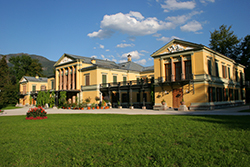 Photo: Sigmund |
|
|||
| The little town of Bad Ischl in Upper Austria, the former summer capital of the great Austro-Hungarian Monarchy, has been associated with the Habsburg imperial dynasty for at least 700 years. The Imperial Villa in Ischl, the Emperor's summer residence, was described by Franz Josef I as "heaven on earth" for himself and his family.
img_2441The Villa was originally a wedding present from his mother, Archduchess Sophie, on the occasion of his marriage in 1854 to his teenage Bavarian cousin Elisabeth. Their engagement had taken place in Ischl the previous year. “Sisi”, as she was known to the family, became renowned as Elisabeth, Empress of Austria, the most famous beauty of the 19th century, and still fascinates a world-wide public. Franz Josef built a personal Cottage for her in the Imperial Park in English 16th-century “Elizabethan” style. The Villa and its estate are still redolent with memories of Elisabeth. The Imperial Villa was also a stage on which the great powers of the 19th century carried out their diplomatic manoeuvrings. It was here, on 28 July 1914, that Franz Josef signed the declaration of war on Serbia that was to escalate into two global conflicts and change the world. Still a haven of peace and tranquillity, and still occupied by the Habsburg descendants of Franz Josef and Elisabeth, the Imperial Villa retains the ambience of a bygone age in the 19th century, and its association with great people and events. It does not take much imagination to visualise the crowned heads and major statesmen of the world who were received here, or the world-famous composers, writers and artists who flocked to Ischl in the wake of the Emperor’s court during the decades of that glorious Indian summer of imperial Austria around the year 1900. This website tells the story. ( kaiservilla.at) |
||||
| „Oh, hogy vágyódom a drága, drága Ischl után” – írta 1845-ben egy édesanyjának címzett levelében az akkor 15 éves Ferenc József koronaherceg. Az uralkodó város iránti vonzalma egészen életén át töretlen és megkérdőjelezhetetlen maradt. A felső-ausztriai Bad Ischlben található Császárvilla – Zsófia főhercegnő ajándéka a fiatal jegyespárnak, Ferenc Józsefnek és Erzsébetnek – sejtetni engedi, hogy a neoklasszicista épület miért nőtt sokkal inkább a császár szívéhez, mint a bécsi rezidenciák pompája. A Császárvilla az uralkodói család menedékhelyeként szolgált a nyári hónapokban, messze a Hofburg és a Schönbrunni kastély szigorú protokolljától. A bájos épület ugyanakkor számos fontos döntés helyszíne is volt: Ferenc József császár számos magas rangú államférfit fogadott a villában, és itt írta alá 1914-ben a Szerbiának szóló hadüzenetet. A változatlanul megőrzött helyiségek rég letűnt idők hangulatát idézik. A látogatóknak úgy tűnhet, mintha Ferenc József császár csak néhány pillanattal ezelőtt hagyta volna el dolgozószobáját, hogy kedvelt szabadidős tevékenységének, a vadászatnak hódoljon, vagy Erzsébet császárné épp csak a környező parkban tett könnyed séta kedvéért szakította meg rendszeres fitneszprogramját. ( Austriainfo) |
||||
|
Kittsee-kastély |
||||
 |
||||
| The new Castle (Schloss Kittsee) was built in 1668 by expanding the Grange. Since 1974 it houses an ethnographic museum. Here lived the 'poor doctor' and köpcsényi hospital founder László Batthyány Strattmann. (forrás: Wiki) | ||||
| Az új kastély a község nyugati szélén áll. Kovácsoltvas kapuja az 1900-as párizsi világkiállításon az osztrák-magyar pavilont díszítette. A kapu jobb oldalán mléktábla:„Batthyány-kastély. Itt élt a ’szegények orvosa’ és a köpcsényi kórház alapítója Batthyány-Strattmann László. 1870-1931.” Az épület magja 17. századi eredetû. Mai, barokk formáját Eszterházy Pál herceg alakíttatta ki 1730 és 40 között. 1870 után a kastély tulajdonosa a Batthyány-család lett. Az U alakú épület leghangsúlyosabb része az udvar felöli középrizalit. Erkélye 1909-ben épült, s atlaszok támasztják alá. A szobrok a pozsonyi nyári prímási palotából származnak (18. század elsõ fele). Az udvart beüvegezett árkádsor szegélyezi. Az épületben 1974-tõl néprajzi múzeum mûködik. (sulinet.hu) |
||||
| Kreuzenstein-vár | ||||
| The origins of Burg Kreuzenstein, like most castles in Lower Austria, date back to the 12th century. Originally built by the Counts of Formbach (now Vornbach, Bavaria), the castle passed into the possession of the Counts of Wasserburg through marriage. Through Ottokar II of Bohemia, the castle came into the possession of the Habsburgs, in 1278. In July 1527, the Anabaptist preacher Balthasar Hubmaier was arrested under the pretext of causing riots in Mikulov, Moravia and transferred to Burg Kreuzenstein. He was interrogated there but refused to renounce his beliefs and was burned at the stake in Vienna. Until the Thirty Years War, the castle had never been conquered but then it fell into the hands of the Swedish Field Marshall Lennart Torstensson, who, on his departure in 1645, blew up three parts of the building (some sources say four). The reconstruction under the Counts of Wilczek Interior of Burg Kreuzenstein by Austrian artist Franz Poledne (1873 - 1932) In the 18th century, the castle came into the possession of the Counts of Wilczek who had amassed a large fortune through their coal mines in Silesia. In 1874, Count Johann Nepomuk Wilczek, best known as a polar explorer, began reconstruction of the castle but in a style entirely different from the original Romanesque-Gothic architecture. The existing ruins were incorporated into the new castle, in particular, parts of the outer wall, the east tower and parts of the chapel. The practised eye can easily distinguish between the surviving medieval masonry and the 19th century additions. The reconstruction was overseen by architect Carl Gangolf Kayser until his death in 1895, at which time it was taken over by Ritter Humbert Walcher of Molthein and the artist Egon Rheinberger. A family vault was built under the castle and Johann Wilczek is interred there. As well as building the castle from the original masonry and on the original site, Wilczek gathered building components from all over Europe. Additionally, the castle was equipped with a large collection of medieval furnishings and historical artefacts, including one of the oldest surviving medieval catapults, purchased from Hohensalzburg Castle. The reconstruction work lasted for thirty years and Kaiser Wilhelm II was present at the reopening on June 6, 1906. A fire caused by a lightening strike in 1915, burned part of the archives and library wing. Burg Kreuzenstein today |
||||
| Kreuzenstein vára története, csakúgy, mint a legtöbb alsó-ausztriai váré, a 12. századra nyúlik vissza. Az épületet a formbachi (ma Vornbach, Németország) grófi család építtette, majd házasság útján került Wasserburg grófjához. 1278-ban pedig II. Ottokár cseh királyon keresztül került a Habsburgok birtokába. 1527. júliusában az anabaptista Balthasar Hubmaier prédikátort elfogták a morvaországi, mikulovi felkelések indítása miatt és Kreuzenstein várába szállították. Kivallatták, de nem volt hajlandó megtagadni hitét, ezért Bécsben máglyára vetették. A Harminc éves háború alatt ugyan a várat nem foglalták el, de abban az időben került a svéd tábori vezér Lennart Torstensson birtokába, aki 1645-ben egyes források szerint három, mások szerint négy részét felrobbantatta az erődnek. A 18. században már a Wilczek grófok birtokolták a várat, akik vagyonukat a sziléziai szénbányáikból szerezték. 1874-ben Johann Nepomuk Wilczek gróf, sarkkutató újjáépítésbe kezdett, de immár teljesen más építészeti stílusban gondolkodott, mint a kor meglévő stílusa, román kori - gótikus stílusban terveztette. A meglévő romokhoz épült az új kastély, a külső kárfal, a keleti torony és a kápolna egy része. Azonban a gyakorlott szem könnyedén megkülönbözteti a középkori falazatot a 19. századi toldásoktól. A rekonstrukciót Carl Gangolf Kayser építész vezette az 1895-ben bekövetkezett haláláig, majd Ritter Humbert Walcher of Molthein és a művész Egon Rheinberger folytatta. Wilczek gróf Európa különböző pontjairól hozatta az építőanyagot. Számos középkori bútort, történelmi emléket gyűjtött össze a várban, többek között ide került Hohensalzburg várából a legrégebbi létező középkori katapult is. Az átépítés 30 évig tartott és II. Vilmos is részt vett a megnyitó ünnepségén 1906. június 06-án. 1915-ben villám csapott a várba, melynek következtében leégett a levéltár és a könyvtár egy része. A német Wehrmacht és a Vörös Hadsereg 1945-ös konfliktusa a várat sem kímélte, néhány szobája jelentős károkat szenvedett és a gyűjtemény egy részét ellopták. Számos kéziratot azonban sikerült megmenteni, most az Osztrák Nemzeti Könyvtár kollekciójának része. A vár jelenlegi tulajdonosa Hans-Christian Wilczek gróf. Az épület a Jeruzsálemi Szent Lázár Katonai és Kórházi Lovagrend egyik székhelye. A vár csak vezetett túrán tekinthető meg áprilistól október végéig, ahova egy mély szakadék felett átívelő hídon keresztül lehet bejutni. A kápolna a vár egyik legfigyelemreméltóbb része amelynek legrégebbi darabja egy, a 8. századból származó ókeresztény relief, de lenyűgöző látványt nyújtanak a gótikus oltár és a mozaik ablakok is. Az épület termein végighaladva megelevenedik előttünk a középkori nemesi élet, többek között bemutatásra kerül Ausztria egyik legnagyobb magán fegyvergyűjteménye is. Időről időre madarász bemutatókat tartanak a birtokon és a közelmúltban kialakították a középkori éttermét is. Mára a vár kedvelt idegenforgalmi célponttá vált. Egy időben a Burgserenade néven évente megtartott komolyzenei koncertnek adott helyet az épület. (Wikipédia) |
||||
| Lamberg-kastély | ||||
|
|
||||
| Lamberg Castle first appeared in historical documents as "Stirapurhc" in 980. The remains of the former fortress can only be seen in fragments of the mighty bailey. In the 11th century the Castle was the residence of the Otokar Dynasty. In 1727 the whole structure was destroyed by a great fire. As a result the Castle was completely rebuilt in lavish Baroque style by the Counts of Lamberg. The Lamberg Castle Library and the precious sandstone figures can be admired in the castle´s inner courtyard. ( steyr.info) | ||||
| Steyr város barokk kastélyát egy 980 körül épült vár romjainemelték. Ma Felső-Ausztria legnagyobb magánkönytárának ad otthont. | ||||
|
Laxenburg-kastély |
||||
 |
||||
|
Laxenburg is situated about 15 km south of Vienna. The historical importance of the village “Lachsendorf” has its roots in the 13th century and it was already in 1388 under the reign of duke Albrecht III that Laxenburg became a “Marktgemeinde” (a special kind of village in Austria). Even in these days, thanks to the vicinity of Schönbrunn castle, Laxenburg was the preferred residence during spring and summer of the imperial family. The castle grounds are without any doubt the heart of Laxenburg. Laxenburg castle is one of the most impressing in castles in Europe. Its castle grounds are considered to be a showpiece as far as it concerns the horticulture of the 18th/19th century. It was Maria Theresia together with her grand-son, emperor Franz who were responsible for the expansion of the park to 280 hectares. The gardens are decorated in a lovely and fanciful way. In addition to the “blue court” (“Blauer Hof”) there is a high number of buildings of joy, mystical grottos, temples and the medieval tournament site. The best-known building is certainly the “Franzensburg” (a castle) which was built in the period from 1799 to 1801 and which was completed in 1835. It was emperor Franz II who was responsible for the construction of this reproduction of a medieval knights castle on an artificial island in the middle of the castles pond. Laxenburg Bécstől körülbelül 15 kilométerre délre fekszik. „Lachsendorf” település történelmi jelentősége a 13. századig nyúlik vissza, és Laxenburg már 1388-ban III. Albert herceg idején községi rangra emelkedett. A schönbrunni kastély közelségének köszönhetően Laxenburg már ebben az időben a császári család kedvelt tavaszi és nyári rezidenciájává vált. |
||||
|
Laxenburg község szíve természetesen a kastélypark. A Laxenburg-kastély az egyik legimpozánsabb kastély Európában. A kastélypark a 18. és 19. századi kertépítészet mintapéldája. Mária Terézia császárnő és unokája, Ferenc császár a park területét 280 hektárra bővíttette ki. Az impozáns park kedves és játékos módon lett kialakítva. Az új kastély és a Blauer Hof mellett szórakoztató célú épületek sokasága, misztikus barlangok, templomok, illetve egy, a középkort idéző tornatér található itt. A legismertebb épület minden bizonnyal a Franzensburg, amely 1798 és 1801 között épült, és 1835-ig folyamatosan bővült. II./I. Ferenc császár egy középkori lovagvár utánzatát építtette a kastélytó közepén kialakított mesterséges szigetre. A ma múzeumként megtekinthető helyiségek felszereléseit Ausztria kincsesházaként is emlegetik. Sissi császárné a pompás esküvőt követően itt töltötte mézesheteit Ferenc József császárral. Közismerten szívesen lovagolt ki a laxenburgi erdőkbe. A Laxenburg-kastélyban született Rudolf koronaherceg és lánytestvére, Gizella főhercegnő is. A Laxenburg-kastélypark teljes egészében műemlékvédelem alatt áll, és Natura 2000 területté nyilvánították. A vonzó szabadidős létesítmények évente több mint egymillió vendégnek nyújtanak szórakozást. Panorámavasút halad el a látnivalók előtt, és a régió legnagyobb természetközeli játszótere vár arra, hogy felfedezzék a gyerekek. Legyen szó sportról (csónakkölcsönzés a 25 hektár méretű kastélytavon), kultúráról (idegenvezetés a Franzensburg Múzeumban, illetve a „Magas toronyban és a háztetők fölött”), vagy ínyenc gasztronómiai kínálatról, Laxenburgot a változatosság és a kellemes hangulat jellemzi. (schloss-laxenburg.at) |
||||
|
Leopoldskron-kastély |
||||
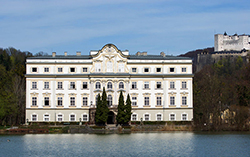 Photo: Simon |
||||
| Schloss Leopoldskron was commissioned as a family estate in 1736 by the Prince Archbishop of Salzburg, Leopold Anton Freiherr von Firmian (1679-1744). The Scottish Benedictine monk, Bernhard Stuart, is regarded as Leopoldskron's master builder. In addition, Johann Kleber's stucco work on the ceilings throughout the Schloss is described as “the best example of rococo stucco the land can offer”.
Leopold Firmian was a great lover of science and the arts, but is most remembered for his role in the expulsion of more than 22,000 Protestants from the Archbishopric of Salzburg. Leopold’s harsh actions were noticed all over Europe and both Salzburg’s economy and the reputation of the Firmian family suffered severely as a result. The commission of Schloss Leopoldskron was, in part, an attempt by the Archbishop to rescue the social standing of his family. A special law made the property a private possession of the family. In May 1744, Leopold deeded the completed Schloss over to his nephew, Count Laktanz Firmian. After his death later in the same year, the Archbishop’s body was buried in Salzburg’s cathedral, but his heart remains below the Chapel in the Schloss, which, as is inscribed on the chapel floor, he “loved so dearly.” Count Laktanz, a collector of art and an artist himself, enriched Schloss Leopoldskron with the largest collection of paintings Salzburg had ever known, including works of artists such as Rembrandt, Rubens, Dürer, and Titian. The Count was one of the first sponsors of Leopold Mozart and his son, Wolfgang Amadeus. When Laktanz died in 1786, his son started selling the famous paintings and Leopoldskron experienced a time of decline. In 1837, when it was sold to George Zierer, owner of a local shooting gallery, the collections were dismantled and removed most of the remaining valuable paintings, etchings, and sculptures were removed. During the 19th century the Schloss passed through various hands, among them Bavarian King Ludwig I and Carl Spängler, a well-known banker and two waiters who attempted to turn it into a hotel. (schloss-leopoldskron.com) |
||||
| A Leopoldskron kastélyt Leopold Anton Freiherr von Firmian (1679-1744) salzburgi hercegség érsekének megbízásából építették a családi birtokon 1736-ban. A skót bencés szerzetes, Bernhard Stuart, tekinthető Leopoldskron a főépítészének. Ezen kívül, Johann Kleber mennyezeti stukkói a világonlegszebb példái a rokokó stukkódíszítésnek. Leopold Firmian nagy szerelme a tudomány és a művészet, de leghírhedtebb cselekedete az volt, hogy kiutasított több mint 22.000 protestánst az salzburgi érsekség területéről. Leopold durva akciójának híre ment Európa-szerte, és a kiutasítást a salzburgi gazdasági élet is megszenvedte, valamint a Firmian család jó hírnevét is elvesztette. Leopoldskron védelmére egy külön törvényt hoztak. 1744 után Leopold unokaöccse, gróf Laktanz Firmian lett a kastély tulajdonosa. Halála után még ugyanabban az évben, az érsek holttestét salzburgi katedrálisban temették el, de az érsek szívét a kastély kápolnájában temették el. A kápolna padlójába most is olvasható egy felirat: "hőn szeretett kincsem." Gróf Laktanz, műgyűjtő és művész volt, aki, kibővítette a Leopoldskron kastély festménygyűjteményét. A salzburgi kastély leghíresebb festménygyűjteményébe olyan híres festők munkái kerültek, mint, mint Rembrandt, Rubens, Dürer, és Tiziano. A gróf volt az egyik első támogatója Leopold Mozartnak és fiának, Wolfgang Amadeus-nak. Amikor Laktanz meghalt 1786, a fia elkezdte értékesíteni a híres festményeket, és elkezdődött Leopoldskron hanyatlása. 1837-ben, amikor George Zierer vette meg,de ő eltávolíttatta a gyűjteményeket, értékes festményeket, rézkarcokat, és szobrokat. A 19. században a kastély több kézen ment át, köztük bajor király I. Lajos és Carl Spangler, egy jól ismert bankár és két pincér hotelnek alakította át. |
||||
|
Linz-kastély |
||||
 Photo:Linz.at |
||||
| The most important objects relating to the art and cultural history of Upper Austria are shown in the renaissance building of the Linz Castle. Special focal points are collections of Gothic art and paintings from the 19th century, objects from the popular culture of Upper Austria, e.g. lovely traditional costumes and golden hats typical for the province, collection of arms and armors and the mintage cabinet. The permanent exhibition in the basement leads you back to the roots of Upper Austria, from the prehistory to the Romans and the Middle Ages. In addition the castle museum offers regularly big special exhibitions about cultural, artistic and natural science. (linz.at) |
||||
| Az egyik legfontosabb művészeti és kulturális emléke felső-Ausztriának a reneszánsz linzi vár. A speciális központban tárolnak gótikus művészeti műtárgyakat, festményeket a 19. századból, valamint felső-Ausztria népművészeti értékeit, pl. a megyére jellemző viseletet, (kosztüm és az arany kalap), fegyvereket és páncélzatot és a pénzveréssel kapcsolatos felszerelést. Az állandó kiállítás az alagsorban látható, mely visszavezet felső-Ausztria prehisztorikus és római középkori történelmébe. Ezenkívül a kastélymúzeum rendszeresen kínál különleges kulturális, művészeti és természettudományos kiállításokat. | ||||
|
Litzlberg-kastély |
||||
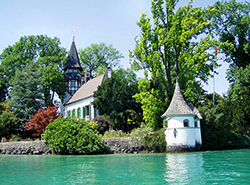 Photo: Anzi9 |
|
|||
| The name is originally Lützelburg means and small castle; Illustrations from the 17th Century show a handsome plant, which end of the 19th Century. was finally forfeited in its entirety. The new building in the style of historicism, dates from around 1900. The bridge to the island was buildt 1917th Island and the castle is privately owned and not open to the public! (oberoesterreich.at) | ||||
| Az eredi kastélyépület a 17. századból származzott, de semmi nem maradt meg belőle. Az új épület historikus stílusú és 1900-ból származik. Az épület magántulajdonban van, és nem látogatható. back | ||||
|
Loosdorf-kastély |
||||
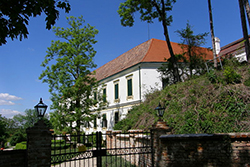 Photo: JonnyBrazil Photo: JonnyBrazil |
||||
|
The begining of the castle history goes back to the 12th century.Todays form was built by Prince Liechtenstein, but the John the son of the Prince Emanuel renovated it in the end of the 18th century which created the form too. Currently the owner is the Piatti family. The castle has a romantic park and viewed the family china and also some decorative items are presented in the museum of the castle. The castle is located about 60kms of Vienna. A kastély történetének kezdete egészen a 12. századik nyúlik vissza. Mai formája Liechtenstein hercegnek köszönhető, de Emánuel herceg és fia János, a 18-ik század végén az épületet renováltatta, így nekik is köszönhető a jelenlegi forma. A Piatti család leszármazottjai jelenleg a kastély tulajdonosai. A kastélyhoz romantikus park is tartozik, és megtekinthető a család porcelán, és dísztárgyakat is bemutató gyűjteménye a múzeumban. A kastély kb 60km-re található Bécstől. |
||||
|
Maria Loretto-kastély |
||||
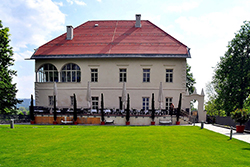 Photo: JohannJaritz |
||||
| Maria Loretto castle was built in 1652. The original castle building burned down in 1708. The new building was built in the 18th century simple. Many time ago it was an island, but today it is accessible by land. At the end of 2002 the city of Klagenfurt bought the castle from the Orsini-Rosenberg family. Also we can see the wonderful black Madonna of Loretto, which is located in the chapel on the peninsula. | ||||
| Maria Loretto-várát 1652-ben építették. Az eredeti vár épülete 1708-ban leégett. Az új egyszerű épület 18. században épült. Valamikor szigeten állt, de ma már szárazföldön megközelíthető. 2002 végén Klagenfurt városa a Orsini-Rosenberg családtól, megvásárolta a kastélyt. Szintén a félszigeten található csodálatos fekete Loretto-i Madonna, amely a kápolnában lett elhelyezve. | ||||
|
Mirabell-kastély |
||||
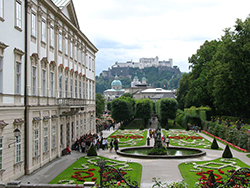 photo:Andrew Bossi |
||||
Mirabell Palace (German: Schloss Mirabell) is a historical building in the city of Salzburg, Austria. The palace with its gardens is a listed cultural heritage monument and part of the Historic Centre of the City of Salzburg UNESCO World Heritage Site. It was built about 1606 outside the medieval walls of Salzburg according to Italian and French models, at the behest of Prince-Archbishop Wolf Dietrich Raitenau as a residence for his mistress Salome Alt. When Raitenau was deposed and arrested in 1612, Alt and her family were expelled and the palace received its current name from Italian: mirabile, bella: "amazing", "wonderful". It was rebuilt in a lavish Baroque style from 1710, according to plans designed by Johann Lukas von Hildebrandt. On 1 June 1815 the later King Otto of Greece was born here, while his father, the Wittelsbach crown prince Ludwig I of Bavaria served as stadtholder in the former Electorate of Salzburg. The current Neoclasical appearance dates from about 1818, when the place was restored after a blaze. In its geometrically-arranged gardens are mythology-themed statues dating from 1730 and four groups of sculpture (Eneas, Hercules, Paris and Pluton) by the Italian sculptor Ottavio Mosto, from 1690. It is noted for its boxwood layouts. (Wiki) |
||||
| Az egykori Altenau kastély 1606-ban épült, Wolf Dietrich von Raitenau szerelmi ajándékként kedvesének, Salome Altnak. Wolf Dietrich halála után követője Markus Sittikus Mirabell kastélynak keresztelte át. A XVIII. század elején építették át először Franz Anton Harrach érsek megbizásából, csodálatos barokk kastélyt varázsolva belőle, majd 1818-ban a nagy tűzvész szinte teljesen elpusztította a katély épületét. Csak az első emeleti márványterem és a nyugati szárnyban található lépcső maradtak épen. Jelenleg a Mirabell kastély a Salzburgi polgármester és néhány városi hivatal székhelyeként szolgál. A világ minden tájáról érkező jegyespárok választják esküvőjük színhelyéül a márványtermet. Számtalan esküvői fénykép készül a márványlépcső angyalkája és a Mirabell kert szökőkútja előtt. A kastély márványtermében már Leoporld Mozart és a gyermek Wolfgang is zenélt. Mirabell kert: A Mirabell kert virágok és szobrok színes világát tárja a látogatók elé. Művészien metszett nővények, sétalugasok, csodállatos virágkülönlegességek és szökőkutak láthatók itt. |
||||
|
Obermayerhofen-kastélyhotel |
||||
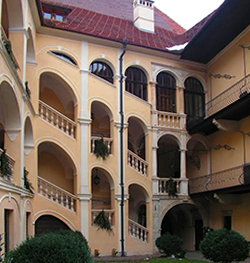 Photo: Szalai Gábor |
||||
| A fortified farm was erected at the site of Obermayerhofen in 1170. A Castle built for its protection, stood nearly but no dates are known about its existence. It’s owner in 1315 is Heinrich Mayerhofer, bishop of Gurk and dean of St. Stephans cathedral in Vienna. One of his descendants, Konrad sells the property to Knight Härtel of Teuffenbach in 1377. The illustrious Knights of Teuffenbach hold on to Obermayerhofen for almost 230 years, gradually extending their holdings and making Obermayerhofen into the centre of their vast estate. After Bernhard of Teuffenbachs’s death 1540 his four sons inherited equal shares, each one receiving a quarter store of the castle’s fourteen rooms and surrounding land. This led to incessant quarrelling between the brothers, until in 1552 the youngest, Servaz of Teuffenbach, bought out his older brothers and begins the renovate the castle. The work is finished in 1574. During the building works, Andrä one of Servaz of Teuffenbachs’s brothers accuses him of having stolen considerable quantities of building materials from him. In the course of one of their arguments, the Mayerhofen factor, Niklas Protonotzky is killed by Andrä’s son. Servaz vof Teuffenbach's second wife was Katharina von Herberstein. She died 1606 at the age of 64 and is buried in the chapel. The sepulchre is still in place. The Urbar of Obermayerhofen in 1636 describes the castle as being well-built in an exceptionally pleasant location and having attractive rooms. Of particular note were the newly restored chapel- which had been neglected by the Protestant Knights of Teuffenbach, the deep well with its flavoursome water, also its vast gardens including newly established kitchen – and herb gardens and parkland, all surrounded by a brick wall. Josef Graf Kottulinsky bought Schloss and landed property in 1777. He built a new farm, where, on the wall facing the courtyard his crest and that of his wife Elisabeth von Falkenhayn can be seen to this day. After 1848 years, Obermayerhofen was mainly used during the summer and autumn months. After the death of Ernestine Khuen-Belasi, née Kottulinsky, Obermayerhofen was left to her niece Maria, who in turn, left it to Emil Taulow in 1939. After the war, the Schloss was ransacked and badly damaged by occupation troops, and left to delay. Harald Kottulinsky bought back the ancestral Schloss in 1977 and in 1986 established the luxurious hotel. His wife, Brigitte Kottulinsky has been running it since 1991 and extended the park by 140.000m² in 1999. (heiraten-im-schloss.info) |
||||
| Obermayerhofen-kastélyt 1170-ben védelmi uradalmi birtokként építették. Hajdanán a teuffenbachi lovagok birtokában is volt a kastély, majd a sok tulajdonosváltás során leamortizálódott.1977 után át kezdték felújítani. A csendes, mint egy zöld szigeten fekvő családikastélyt 1986-ban modern komforttal ellátva, kastélyszállóvá (22 kétágyasszobával) alakították. Ünnepélyes családi rendezvények megtartására egy (130 fős) díszterem áll rendelkezésre. A barokk kastélykápolnában zajlik az egyházi esketési szertartás. A kastélyétterem Stájerország legjobb éttermei közé számít. (steiermark.at) |
||||
|
Ort-kastély |
||||
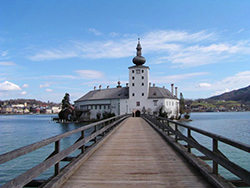 Photo: Christian Jansky (UserTschaensky) |
||||
| The castle was founded around 1080 by Hartnidus of Ort, and improvements continued to be made into the thirteenth century - for example by Hartnidus V in 1244. In 1344 the brothers Friedrich and Reinprecht I of Wallsee purchased the castle, which became Friedrich’s sole possession on January 25, 1350. The castle remained in the possession of the Wallsee family until 1483, when Schloss Ort passed to Frederick III, Holy Roman Emperor. From 1484 to 1491, the castle was governed by Gotthard von Starhenberg, the Governor of Upper Austria. In 1492, Bernhard of Starhenberg and later his descendants ruled the castle until 1584. In 1588, the castle was purchased by Weikhard Freiherr of Pollheim, but he sold the castle on April 6, 1595 to the city of Gmunden. However, Gmunden sold the castle to Rudolf II that same year. The castle then passed to other owners before finally being acquired by Leopold I, Holy Roman Emperor. In 1876, the castle was acquired by Archduke John Salvator of Austria (John of Tuscany) (1852-ca. 1911), but on October 6, 1889, he renounced his title and connections to the Habsburg imperial house and changed his name to Johann Orth, the tenth and last child of Grand Duke Leopold II of Tuscany and Maria Antonietta of the Two Sicilies departing for South America in 1890 with his morganatic wife on his own ship, the St. Margaret.[1] Johann Nepomuk Salvator was presumed lost at sea in 1890, and declared dead in 1911, but his actual date of death is unknown The castle was acquired by Franz Joseph I of Austria in 1914, and it was intended for students of Gmunden’s schools to be allowed to visit the castle, but this plan was interrupted by World War I. The castle was not well maintained between 1919 and 1973. At present the castle is being used for study center of the Federal Ministry for Land and Forestry (Bundesministeriums für Land- und Forstwirtschaft). On January 5, 1995, the castle was officially acquired by the city of Gmunden. (Wiki) |
||||
| A szigeten az első épület római eredetű volt. A történelem során később III. Frigyes német-római császár, és I. Lipót német-római császár is tulajdonosa volt az épületnek. A várat I. Ferenc József osztrák uralkodó szerezte meg 1914-ben, és úgy tervezte hogy látogathatóvá teszi a gmundeni diákok számára, de a tervet az első világháború meghiúsította. Jelenleg erdészeti oktatási központként működika vidékterületfejlesztési és erdőgazdálkodási minisztérium irényítása alatt. | ||||
|
|
||||
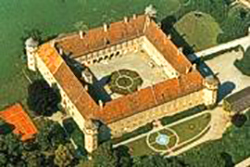 Photo: Aladyn0815 |
||||
| The former water castle was rebuilt into baroque style by the design of Domencio Carlone between 1660 and 1667. The interior decorating was made by some famous Italian masters like Thadeo Piro, Carpoforo Tencalla fresco master, Giovanni Catello and Giovanni Piazoll builder. In 1683 during the Turkish invasion towards Vienna fire destroyed the building and it had to be rennovated. The indoor baroque rooms have fantastic decorations.Several films were made here for example The Three Musketeers by Charlie Sheen, Chris O’Donnell and Kiefer Sutherland. | ||||
| Az egykori vízivárat 1660 és 1667 között kora barokk stílusú kastéllyá építették át Domenico Carlone tervei alapján. A belső díszítést kiváló olasz mesterek készítették el (Thadeo Piro, Carpoforo Tencalla freskómester, Giovanni Castello és Giovanni Piazoll kőmívesek). 1683-ban a Bécs felé nyomuló török hadsereg támadása miatt tűzkár keletkezett az épületben, átépítették, renoválták. A barokk belső terek kiemelkedően szép díszítéssel ellátottak. A kastélyban több filmet is forgattak. Például A három muskétás című filmet is Charlie Sheen, Chris O’Donnell és Kiefer Sutherland főszereplésével. | ||||
|
|
||||
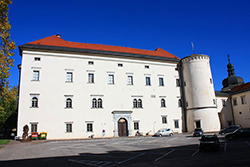 Photo: Mefusbren69 |
|
|||
| Schloss Porcia (Porcia Castle) is a castle in Spittal an der Drau, in the Austrian state of Carinthia. It is one of the most significant Renaissance buildings in Austria. Construction of the edifice began in 1533 by Count Gabriel von Salamanca-Ortenburg (1489–1539), treasurer of the Habsburg archduke Ferdinand I of Austria. Originally from Burgos in Habsburg Spain, Salamanca in 1524 for his services had received the County of Ortenburg in the Imperial Duchy of Carinthia. The Ortenburg dynasty had become extinct in 1418 and since their ancestral seat Ortenburg Castle did not meet Salamanca's standards, he commissioned the design of his new comital residence in Spittal to Italian architects. However he never lived here, as the construction in a palazzo style continued until 1598. Schloss Porcia, engraving, 1688. After the Salamanca dynasty had become extinct in 1620, the patrician Widmann family acquired their estates and in 1662 assigned the castle to Prince John Ferdinand of Porcia, at this time minister and confidant of the Habsburg emperor Leopold I. His descendants added Baroque elements to the façade in the 18th century, while the adjacent park was laid out in the 19th century. Not until 1918 did the Porcia family sell the castle, which in 1951 became a property of the Spittal municipality. The famous arcaded courtyard houses several Lombard-Italian sculptures and serves as a venue for the annual Komödienspiele Porcia festival. Furthermore the castle houses a museum for local history and is the site of several concerts and chorus recitals. Porcia Castle is notorious for the ghost of the White Lady Katharina of Salamanca, who is said to be guilty of remorselessness towards her subjects and cursed to haunt the rooms of the castle. (Wiki) |
||||
|
A Porcia kastély reneszánsz formáját elsősorban a salamancai vérvonal irányításával érte el. Az épület 1597-1598-ban készült el. A homlokzat a külső és belső architektúráját meghatározzák az oszlopok, és a három emeletes árkádok. A formai világára inkább jellemző az olasz Palazzo élmény. 1662-ben a Pordenone olasz nemesi család vette meg, akikről a vár a nevét kapta, Porcia. A családnak nagy vagyona volt Karintiában. Herceg Johann Ferdinand a Portia, a miniszter,és I. Lipót és 13. utódai is gyakran tartózkodott itt, egészen 1918-ig. Napjainkban a több funkciós épületben megtalálható a népi kultúra múzeuma, látható kultúrtörténeti kiállítás Felső Karintiáról, és 3D mozi is. |
||||
|
|
||||
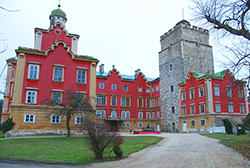 Photo: Koeppik |
|
|||
| The town’s greatest architectural attraction, however, is the Prugg, a 13th-century castle with an original earlyGothic turret. In 1707, Lukas von Hildebrandt altered the castle in the Baroque style. | ||||
| A kastély története 1242-ben kezdődik. Alapvetően végvárnak építették, mégis a török hadseregnek sikerült elfoglalnia 1490-ben. 1707 és 1711 kőzőtt átépítették Johann Lucas von Hildebrandt építész irányításával olasz mesterekkel (Johann Bendl szobrász, Giovanni Stanetti és Joseph kőfaragók, Alberto Camesina és Santino Bussi kőművesek, Bartolomeo Altomonte freskófestő). 1792-ben gróf Johann Harrach tovább fejlesztette a kastélyt, amely nagyobb lett, és romantikus, neo-gótikus stílus elemekkel lett kiegészítve. 1850-ben Charles Lamb Buckton tervei alapján az egész kastélyt ismételten átépítették. Az új stílus a Tudor lett. 1945 után a kastélyt teljesen kifosztották. A kastély tulajdonosa jelenleg is, a Harrach család. Sajnos az épület nincs nyitva az idegenforgalom előtt, de a park szabadon látogatható. |
||||
|
|
||||
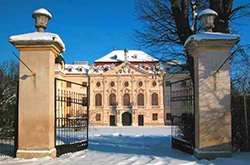 Photo: GuentherZ |
|
|||
| Acquisition of the Castle of Riegersburg by the imperial Count Sigismund Friedrich Khevenhüller in 1730. by Ernst Dieter Petritsch Like many other castles, the fortress of Riegersburg, already mentionned in documents in 1427, had during the course of the centuries, an adventurous life. The Imperial Count Sigmund von Hardegg (1539-1599) bought the fortress in 1568 from the Lords of Eitzingen who owned it since already 1441. On the foundations of the fortress he let built a castle with pillars on moulds and he settled there not only his residence but also the administration center of the County of Hardegg. But Sigmund´s son, Johann Wilhelm von Hardegg incurred in so many debts in buying some properties which had themselves further debts, so that when he died on 1635 bancrupcy was eclared on his succession. In order to finalize the negociations with the creditors, the heir, Count Julius von Hardegg (1594-1684) after long discussions, signed with them an agreement and paid all the debts. To be able to do it, he sold the County of Hardegg and Riegersburg. The new owners were the Counts of Saint Julien Wallsee, who were in those days still under age. Their father Henri Guyard, Comte de Saint Julien (1590-1642) was married with the sister of the above mentioned Count Julius von Hardegg, Sidonia Elisabeth (1619-1651). For religious reasons he emigrated in previous days from France and entered into the imperial army service first as a treasurer and ventually as „Hofkriegsrath“ (Imperial Counsellor of the Army). After he had bought the the Estate of Niederwalisee, he and his descendents were created Imperial Counts of Wallsee. Henri, grandson of Johann Julius de Saint Julien Wallsee (1702-1783) inherited at the death of his father (1728) of the County of Hardegg, first together with his brother Johann Leopold, and became full owner only beginning of 1730. But already the 1st august of the same year he sold the County with all ist estates to Count Sigismund von Khevenhüller. Sigismund Friedrich von Khevenhüller (17.9. 1666 -8.12. 1742) made a brilliant career as a civil servant: in 1694 he became Counsellor of State in the Regional Austrian Government in Graz, from 1698 to 1711 Governor of the Carinthian Province, in 1701 Imperial Counsellor and from 1711 onwards, Governor of the Province of Lower Austria and President of the Austrian Council. In 1721 he was made Knight of the Golden Fleece and short after Minister of the State Council. But the highest reward was for sure the title of Imperial Count which was granted to him and his descendants in 1725. The 1st of august 1730, Count von Khevenhüller signed in Vienna a purchasing act fort he County of Hardegg with the estates of Riegersburg, Prutzendorf, Untermixnitz and Obermixnitz. Together with his son, Count Johann Joseph von Khevenhüller (who had also signed the purchasing act) he left already on 5th of august from Vienna „ to go to get acquainted with the „possessions“ bought from H.E. the Count Julius von Saint Julien and to take possession of the County of Hardegg on the Thaya river with its estates of Riegersburg and Prutzendorf at seven stage-coach stations from Horn….and for the fidelity swearing ceremony of the subjects“ In those days the castle of Riegersburg was mainly in bad conditions and could not be lived in. Therefore big restoration works had to be done rapidly. They lasted for many years and were done after the plans of the landscape architect Franz Anton Pilgram (1699-1761), a scholar of Lukas von Hildebrandt, originarilly from Lower-Austria. And so the ancient castle of Riegersburg got his splendid shape still existing now-a-days, of an impressive Baroque Palace. (riegersburg-hardegg.com) |
||||
| Riegersburg név alatt két remek épület is van Ausztriában. A fent bemutatott kastély Riegersburg településen van. Riegersburg fellegvára máshogy Hardegg fellegvára Hardegg településen van a cseh határ közelében. Mindkét épület csodálatos. | ||||
|
|
||||
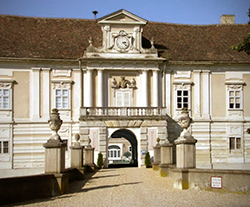 |
|
|||
| Rohrau Castle, an architectural gem, is situated a few miles east of Vienna and houses one of the most famous private collections in Austria. In 1524 the “Veste Rohrau” became the property of the Harrach family, who converted it into one of the most beautiful country castles of Austria. Serving as the residence of the Harrach family until 1945, the castle was vandalized in the early post-war period, but later on restored with loving care. Since 1970, it has accommodated the Harrach’s private gallery, compiled by members of this distinguished family over the past centuries. (schloss-rohrau.at) | ||||
| A Rohrau kastély a nagy múltú Harrach család kastélya. Az egykori habsburg Monarchia kiemelkedő családja igen jó felmenőket tudhat magáénak. Több magasrangú diplomata, herceg, és a nápolyi alkirály is a Harrach család nevét viselte egykoron. A család kedvelte a művészetet, és épp ezért 450 év művészeti gyűjteménye látható jelenleg a kastélyban. Az alkotók között neves osztrák, spanyol, olasz és holland festők remekei. | ||||
|
|
||||
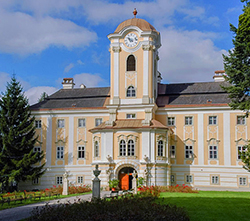 |
|
|||
| The world of Freemasonic symbols in one of the most beautiful Baroque castles in the Waldviertel. The stairway decorated with artistic and masonically interesting frescoes leads to the magnifi cent rooms on the fi rst fl oor where the Austrian Museum of Freemasony is located. This is run by the Rosenau Castle Museum Association and the Grand Lodge of Austria, the latter also arranging regular special exhibitions on Masonic themes. The fi rst rooms lead the visitor into the centre of Masonic thought and work, from “know yourself” to “control – and ennoble yourself” - at the time of the “operative masons” and the cathedral masons’ guilds, where one can also see the famous “window gazer”, the portrait of Masterbuilder Pilgram from St. Stephen’s Cathedral. Beginning with the “dark chamber” in which candidates wait for their initiation, the visitor Fascinating insights intothe history of Austrian and European Freemasonry and its present-day position: Rosenau Castle, the family seat of the Counts Schallaburg, in the Waldviertel, which is so rich in secrets, lies near the town of Zwettl. Hidden in Rosenau Castle, built at the end of the 16th century and later remodelled in Baroque style by Count Leopold Christoph Schallaburg, was an early Freemasons’ Lodge, completely unchanged and maintained in its original form by the later inhabitants of the castle (e.g. Georg Ritter von Schönerer). During the renovation work in the seventies of the last century “strange” and at fi rst inexplicable symbols and wall paintings were discovered. However, several Masons who were also art enthusiasts were able to determine the origin and true use of these rooms and identify them as an 18th century “Lodge. (www.freimaurermuseum.at) | ||||
| Bécstől északnyugatra egy kis faluban Zwettl határában egy kastély rejti Európa egyik legszebb és legnagyobb szabadkőműves múzeumát. Az eredeti tulajdonos, gyakorló szabadkőműves volt, és kastélyán belül kis páholy-templomot alakított ki, ugyanakkor egy másik páholyból csodálatos kilátása nyílhatott a szintén a kastély részét képező barokk katolikus templomra. A folyosókat szabadkűmőves szimbólikus freskók díszítik. A kastély múzeuma 1975-től látható, jelenleg nem csak múzeumként, hanem hotelként, és étteremként is működik. A 16. század végén épült a Rosenau kastély, és később barokk stílusban átalakítatta át gróf Leopold Christoph Schallaburg, és később teljesen változatlan formájában fenntartották a vár további gazdái is: például lGeorg Ritter von Schönerer is. A hetvenes években a felújítási munkálatok során, megmagyarázhatatlan szimbólumok és falfestményekket fedeztek fel. A művészeti kutatások szerint a falfestmények a 18. századi szabadkűmőves páholyhoz kötődnek, és a kastély berendezése és szobái is a szabadkőműves tevékenységet szolgálták. |
||||
|
|
||||
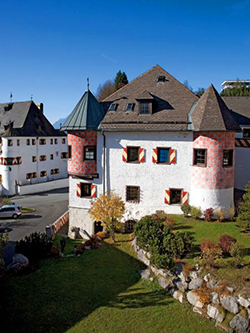 Photo: Rosenegg |
|
|||
| The first record of Rosenegg dates back to 1187. Since then the Schloss Rosenegg has had to withstand many threats and has participated in and formed a lively history.
Centuries and generations have passed and left their mark. Famous people have been guests at the hotel such as the Grand Duchesse Margarethe Maultasch or Napoleon. The Rosenberg barons reigned from 155 to 1760 and where in constant contact with Nostradamus, their good friend. Many letters still remain today. The Baron created the Pillersee Iron and Steel Works which contributed significantly to the development of Fieberbrunn. The 'German Sword' and the entire Habsburg lance weapons collection were produced iron the Pillersee Valley. After religious troubles between Catholics and Protestants, the Rosenbergs fled the country. In 1938 the castle was converted into a hotel and has been in the hand of the Eberhardt family for 3 generations. (schlosshotel-rosenegg.com) |
||||
|
Az első írásos emlék Rosenegg-el kapcsolatban egészen 1187-ből származik. A Rosenegg kastély történelme cselekményekben igen gazdagnak mondható. Az évszázadok és nemzedékek sokféleképpen formálták a kastélyt, és történelmét. Híres emberek is voltak a szállodban, mint a Margarethe Maultasch hercegné vagy Napóleon. A155 évig tartó Rosenberg dinasztia uralkodása alatt egészen 1760-ig, a kastély urai állandó kapcsolatban álltak Nostradamus-al. Ma is láthatóak azok a levelek, melyek a Az első írásos emlék Rosenegg-el kapcsolatban egészen 1187-ből származik. A Rosenegg kastély történelme cselekményekben igen gazdagnak mondható. Az évszázadok és nemzedékek sokféleképpen formálták a kastélyt, és történelmét. Híres emberek is voltak a szállodban, mint a Margarethe Maultasch hercegné vagy Napóleon. A 155 évig tartó Rosenberg dinasztia uralkodása alatt egészen 1760-ig, a kastély urai állandó kapcsolatban álltak Nostradamus-al. Ma is láthatóak azok a levelek, melyek a Nostradamus és a Rosenegg család kapcsolatát bizonyítják. A báró létrehozta a Pillersee Vas- és Fémműveket, amely jelentősen hozzájárult a Fieberbrunn fejlődéséhez. A "német kard", és az egész Habsburg lándzsát fegyverek begyűjtése gyártottak vas a Pillersee völgyben. Miután vallási bajok katolikusok és protestánsok közötti, a Rosenberg elmenekült az országból. 1938-ban a vár alakították át szállodának, és már a kezében a Eberhardt család 3 generáció. (schlosshotel-rosenegg.com)Sok levél ma is fennállnak. A báró létrehozta a Pillersee Vas- és Fémművek, amely jelentősen hozzájárult a fejlődéséhez Fieberbrunn. A "német kard", és az egész Habsburg lándzsát fegyverek begyűjtése gyártottak vas a Pillersee völgyben. Miután vallási bajok katolikusok és protestánsok közötti, a Rosenberg elmenekült az országból. 1938-ban a vár alakították át szállodának, és már a kezében a Eberhardt család 3 generáció. (schlosshotel-rosenegg.com) |
||||
|
Rosenburg-várkastély |
||||
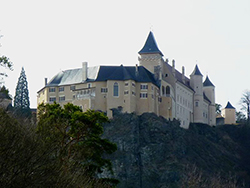 Photo: Juemumue Photo: Juemumue |
|
|||
|
Rosenburg vára (németül Schloss Rosenburg) Rosenburg településen, a Kamp folyó fölött magasodó szikla tetejére épült Ausztriában. A Kamptal Nemzeti Park területén helyezkedik el, mintegy 90 km-re észak-nyugati irányban az osztrák fővárostól, Bécstől. Az ország egyik legszebben megőrzött reneszánsz várkastélyainak egyike. A területen az első várat a 12. században emelték, a legkorábbi írásos emlékei 1175-re nyúlnak vissza. Akkoriban a babenbergi erődítményláncolat részét képezte. A jelenlegi vár alapja és a belső udvar ebből az időből származik. A 15. században Caspar von Rogendorf gróf gótikus stílusban átépíttette és kibővíttette. A kápolna és a külső várfal egy része őrzi ennek az átalakításnak az emlékeit. Számos tulajdonosváltás után Sebastian Grabner 1593-1597 között újabb átalakításokat eszközölt. Egyes gótikus részeit leromboltatta, majd reneszánsz stílusban újjá építtette. Ebben az időben nyerte el a ma is látható alakját a várkastély és ekkor készült el a lenyűgöző 13 torony is. 1614-ben újabb jelentős része, a lovagi torna udvar (amely Európában a legnagyobb) az árkádsorral került kialakításra. Grabner protestáns volt, így az ellenreformáció idején a katolikus Dietrichstein bíboros tulajdonába került a vár. A helyi protestáns közösség - akik a "Horner Bund" (Horni Szövetség - fegyveres ellenálló szövetség) tagjai is voltak - ostrom alá vette és elfoglalta az épületet. Ennek eredményeképpen újabb tulajdonosváltás történt: újra protestáns kézre, a Sprinzenstein család birtokába került 1620-ban. Az 1681. év újabb mérföldkő az épület történetében. Abban az évben Leopold Graf Hoyos gróf feleségül vette Regina von Sprinzenstein grófnőt (von Hoyos-Sprinzenstein). Azóta a Hoyos család a tulajdonosa. 1800-ban tűzvész puszította el az épület nagy részét, és ezen csapás után mintegy 60 évig nem használták a várat. Ernst Carl von Hoyos-Sprinzenstein gróf igazi szívügyeként kezelte az épület sorsát és 1859-1889 között újjá építtette. Ma múzeumként működik és középkori attrakciókkal várja a látogatókat. A várkastély áprilistól októberig (illetve az adventi időszakban néhány napig) tart nyitva. A várban rendszeresen tartanak esküvőket, különböző kulturális rendezvényeket (pl. évente Shakespeare fesztivált rendeznek itt), adventi vásárokat, az udvaron középkori lovagi tornákat, vadászkutya bemutatókat és korhű ruhába öltözött solymászok is tartanak itt madárröptetést. (forrás: Wiki) |
||||
|
The Renaissance castle of Rosenburg with its medieval core, splendid Renaissance arcades, numerous towers and impressive courtyard is considered to be the perfect example of a fortification having gradually evolved over the course of the centuries. The castle is picturesquely situated on a rock high above the River Kamp and is amongst the most visited attractions in Lower Austria. While Grabner was a protestant, the Counter Reformation caused another change in landlords. 1611 Cardinal von Dietrichstein, a catholic leader, was in charge of castle Rosenburg. This did not please the local Protestants that had formed the “Horner Bund” (“Horner Union”, related to the town of Horn nearby). This lead to another change of ownership, the protestant Nobles took over the castle in 1620. 1681 is a landmark date within the history of castle Rosenburg. Again a change of landlords had maneuvered it into the possession of the House of Sprinzenstein. In that year, Count Leopold Graf Hoyos married Countess Regina von Sprinzenstein, the two dynasties merged and were onwards called “von Hoyos-Sprinzenstein”. Since that year the castle remained under the ownership of the Hoyos family until today. In 1800 a disastrous fire destroyed parts of the castle and it was barely used after this stroke for some 60 years. Count Ernst Carl von Hoyos-Sprinzenstein rebuilt it in 1860 with passion and under great personal sacrifice. Since then the castle was constantly maintained and renovated. Part of the daily life in the Renaissance was hunting, especially with falcons. Following this ancient tradition the falconers show different kinds of birds of prey in a daily performance including free flights of the birds. Every first weekend and on bank holidays special shows including falcons, horses, hunting dogs and live medieval music are performed. Visitors interested to learn more about birds of prey can book a Falcon Day and join the falconers a whole day long and observe the fascinating birds as close as possible. Gardens The water-lily pond is the centre of the herbal garden. Different herbs and spices are nursed here finding their way into the kitchen of the nearby Tavern. Strong focus is put on regional plants with tradition and heritage. |
||||
| Rosegg-kastély | ||||
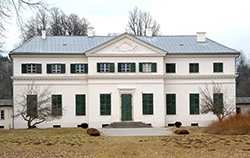 Photo: JohannJaritz Photo: JohannJaritz |
|
|||
|
A kastély építését Orsini-rosenberg herceg olasz szeretője Lukrécia kezdeményezte 1772-ben. A kastély stílusa olasz eredetű, mintáját a Brenta villák adták. Peter Ritter von Bohr alapította a kastély állatparkját, amely jelenleg is nyitva áll a látogatók előtt. A kastély épületében megtekinthető még egy viaszbáb kiállítás ( Napóleon, Sissi, Ferenc József) is. A kastély kertjében pedig Ausztira legnagyobb zöld labirintusában lehet megkeresni a helyes utat, és az állatkert sincs távol a kastélytól. |
||||
| Rosegg Castle has been owned by the Liechtenstein Family since 1831. Prince Johannes von Liechtenstein procured the castle from Peter Ritter von Bohr for one of his sons. The castle was inhabited until the 1970’s, subsequently remaining uninhabited until 1995, but now serving again as a residence since 1997. Visitors can visit Austria’s first “Cabinet of Figures” with its life-size models! Exhibitions by contemporary artists can also be viewed here, while this is also a venue for an array of summer events, concerts, theatrical performances and a small castle café. (woerthersee.com) The castle is near the zoo. | ||||
| Rotschild-kastély | ||||
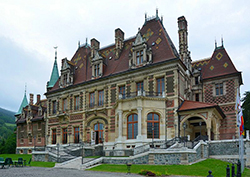 Photo: AWintscalek Photo: AWintscalek |
||||
| A Rothschild-kastély építését 1884-ben rendelték el. A megbízást francia-olasz építészek Armand és Albert Banque Pio kapta meg. A Először a személyzeti szárny épült, fel 1887-ben. Rothschild ki tudja miért , de kiszeretett a reneszánsz elemeket is tartalmazó kastély épületből, és félbemaradt az építkezés. Rothschild odaadományozta az osztrák-magyar hadsereg rokkant tisztjei számára lérehozott alapítványnak. 1900-ban a várat átadták a császári és királyi hadügyminisztériumnak. 1943 és 1945 között az épület kórházként szolgált. A mai tulajdonos az "Egyesült régi osztrák katonai Alapítvány". |
||||
| Reichenau castle was first mentioned in a 1256 deed. Duke Otto IV the Merry, who in 1327 had established the abbey of Neuberg, acquired Reichenau in 1333 and granted it to the monastery.
(Original an ore mining and forestry area, Reichenau due to its picturesque setting became a summer resort of the Viennese nobility in the 19th century. From 1854 on the development of the area was decisively promoted by the opening of the Semmering railway line with a train station in neighbouring Payerbach, part of the Austrian Southern Railway (Südbahn) from the Vienna Südbahnhof to Trieste. Reichenau was directly connected to Payerbach by the Höllentalbahn narrow gauge railway in 1926 at the same time with the opening of the Raxseilbahn, the oldest aerial tramway in Austria.) Hinterleiten Palace In 1872 Archduke Charles Louis of Austria had the Villa Wartholz residence erected near his favourite hunting grounds, according to plans by Heinrich von Ferstel. In 1889 Nathaniel Anselm von Rothschild followed with the building of Hinterleiten Palace. He however did not spend much time in Reichenau and shortly afterwards donated the palais to a veterans foundation, while the Villa Wartholz remained a seat of the Habsburg family, especially of Charles and his wife Zita; their first son, Otto, was born and baptized there, and when Charles become Emperor of Austria, Villa Wartholz was his summer residence in the years 1917 and 1918. |
||||
| Salaberg-kastély | ||||
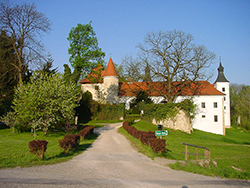 Photo: AWintscalek Photo: AWintscalek |
||||
| The first document was written about the castle in 1282. In 1530 Niclas Cologne Beck Steyr bought it then during the Count Salbergs periodthe building was expanded from 1618. The Salbergs began to evolve it as a real mansion style. The originally renaissance building was destroyed during the two big world wars. Currently the Federal Heritage Office and Cultural Ministry organization the owner of the castle in province of Lower-Austria. The chapel can be rented out for family occations. There is a 33 hectare of zoo in the castle’s park which has 80 animal species of 800 specimens from 5 continents. | ||||
| Az első írásos emlék a várral kapcsolatban 1282-ből származik. 1530-ban a várat Mr. Niclas Cologne Beck Steyr szerezte meg, majd 1618 -tól a Salberg grófok vezetésével jelentősen kibővítették. A Salbergek kezdték meg az épület kastély jellegének kialakíttatását. Eredetileg reneszánsz stílusban épült kastély a világháborúk idején súlyos károkat szenvedett. A jelenlegi tulajdonosa Szövetségi Örökségvédelmi Hivatal és a Kulturális Minisztérium Alsó-Ausztria tartományában. A kápolna kibérelhető családi eseményekre. A kastély fő attrakciója az állatkert. A 33 hektáros kastélyparkban 5 kontinens 80 állatfajának csaknem 800 egyede található. | ||||
| Schönbrunn-palota | ||||
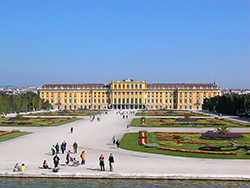 Photo: Alexander Umbricht Photo: Alexander Umbricht |
|
|||
|
Schönbrunn Palace (German: Schloss Schönbrunn ) is a former imperial summer residence located in modern Vienna, Austria. The 1,441-room Rococo palace is one of the most important architectural, cultural and historical monuments in the country. Since 1960s it has been a major tourist attraction. The history of the palace and its vast gardens spans over 300 years, reflecting the changing tastes, interests, and aspirations of successive Habsburg monarchs. In the year 1569, Holy Roman Emperor Maximilian II purchased a large floodplain of the Wien river beneath a hill, situated between Meidling and Hietzing, where a former owner, in 1548, had erected a mansion called Katterburg. The emperor ordered the area to be fenced and put game there such as pheasants, ducks, deer and boar, in order to serve as the court's recreational hunting ground. In a small separate part of the area, "exotic" birds such as turkeys and peafowl were kept. Fishponds were built, too. The name Schönbrunn (meaning "beautiful spring"), has its roots in an artesian well from which water was consumed by the court. During the next century, the area was used as a hunting and recreation ground. Especially Eleonora Gonzaga, who loved hunting, spent much time there and was bequeathed the area as her widow's residence after the death of her husband, Ferdinand II. From 1638 to 1643, she added a palace to the Katterburg mansion, while in 1642 came the first mention of the name "Schönbrunn" on an invoice. The origins of the Schönbrunn orangery seem to go back to Eleonora Gonzaga as well. The Schönbrunn Palace in its present form was built and remodelled in 1740—50s during the reign of empress Maria Theresa who received the estate as a wedding gift. Franz I commissioned the redecoration of the palace exterior in neoclassical style as it appears today. Franz Joseph, the longest-reigning emperor of Austria, spent his last years in the Schönbrunn Palace and died there, at the age of 86, on 21 November 1916. Following the downfall of the Habsburg monarchy in 1918, the palace became the property of newly founded Austrian Republic and was preserved as a museum. After World War II and during the Allied Occupation of Austria (1945—55) Schönbrunn Palace, which was empty at the time, was requisitioned to provide offices for both the British Delegation to the Allied Commission for Austria and for the Headquarters for the small British Military Garrison present in Vienna. Later it was used for important events such as the meeting between U.S. president John F. Kennedy and Soviet premier Nikita Khrushchev in 1961.Since 1992 the palace and gardens are owned and administered by the Schloss Schönbrunn Kultur- und Betriebsges.m.b.H., a limited-liability company wholly owned by the Republic of Austria. The company conducts preservation and restoration of all palace properties without state subsidies.[3] UNESCO catalogued Schönbrunn Palace on the World Heritage List in 1996, together with its gardens, as a remarkable Baroque ensemble and example of synthesis of the arts (Gesamtkunstwerk). (Wikipedia) |
||||
|
A 15. századtól 1642-ig a Katerburg állt itt, amely Hermann Bayer bécsi polgármester vidéki házaként is szolgált. 1569-ben került a Habsburgok kezére, amikor II. Miksa császár megvásárolta, és udvari birtoknak nevezte ki azt. A császár a birtokot dísz- és állatkertnek szánta, ahová egzotikus állatfajokat, így pávát, is telepített, és amelyet vadászatra is előszeretettel használt. A kertet végül 1605-ben a Habsburg abszolutizmus ellen küzdő magyar csapatok pusztították el. A monda szerint a Schönbrunn elnevezés 1612-ből származik, amikor Mátyás császár (II. Mátyás néven magyar király) egy vadászat közben rátalált a Szép Kútra (azaz a Schöne Brunére). A kastély sokáig befejezetlen maradt. 1724-ben VI. Károly császár megvásárolta I. Lipót özvegyétől. Később leányának, Mária Teréziának adta, aki mindig is rajongott a kastélyért és a kertjéért. Mária Terézia uralkodásának kezdetével, 1740-ben a Schönbrunn az udvari élet központjává vált. 1744 és 1765 között Nikolaus Pacassival rokokó stílusban bővítette és alakította át az épületet egy pompás kastélyt létrehozva ezáltal. A 19. században I. Ferenc József uralkodása alatt változott valamit a Schönbrunn. A császár, aki itt töltötte ifjúságát, később rezidenciájául választotta a kastélyt, és itt is halt meg 1916. november 21-én. Ő csak néhány kisebb, belső átalakítást végeztetett el az ifjú Erzsébet császárné fogadása értekében. 1918-ban, a monarchia bukása után az újonnan alakult Osztrák Köztársaság lett a kastély tulajdonosa, és a gyönyörű szobákat múzeummá alakították át. 1945-ben a főépületet és a Gloriette egy részét eltalálták a szövetséges légierők bombái. A második világháború után a kastély épen maradt részében rendezték be a brit megszálló csapatok főhadiszállását. A megsérült részeket részben ekkor, részben a megszálló erők kivonulása után restaurálták. A 20. században a kastély több történelmi esemény színhelye volt; 1961-ben például itt találkozott John Fitzgerald Kennedy amerikai elnök és Nyikita Hruscsov szovjet pártfőtitkár. A nyugati szárny első emeletén találhatók meg a császári pár (I. Ferenc József és Erzsébet császárné) lakosztályai. A keleti részben Mária Terézia kvártélyai, valamint az ún. Ferenc Károly-lakosztályok kaptak helyet, melyekben a császár szülei, Ferenc Károly főherceg és Zsófia főhercegné élték mindennapjaikat. |
||||
| Seggau-kastély | ||||
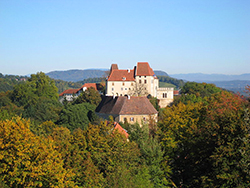 Photo: BambooBeast Photo: BambooBeast |
||||
| Schloss Seggau is a castle situated in the locality Seggauberg in southern Styria, Austria. It is located on a wooded hill overlooking the town of Leibnitz. Schloss Seggau is situated at an height of 344 meters. The area around Schloss Seggau has been settled since at least the Roman era, as demonstrated by the impressive lapidarium which has survived from that period. The upper castle was built by the Archbishopric of Salzburg in the twelfth century as a base for missions and supervision and this original structure was expanded in 1218 by the bishops of Seckau. Over time, a total of three castles were built: Burg Leibnitz (belonging to the Archbishopric of Salzburg), the castle of the bishops of Seckau, and Schloss Polheim. The castles were completed in their present form under Bishop Johann Ernst, Count of Thun, in the latter half of the seventeenth century. Schloss Seggau was the residence of the bishops until 1786, after which it remained their summer residence until into the twentieth century. Schloss Seggau now serves as a site for seminars and conferences with a hotel and a "Schloss Cafe". The wine cellar is over three hundred years old and offers the opportunity for wine tastings and sales. |
||||
| A hegytetőn 3 épület található. A Polheim grófok kastélya mellett a salzburgi hercegség vára és egy apátság is épült itt. A kastély környezetének története a római időkbből vezethető le. A kastély a 19. században érseki palota, és nyári rezidencia volt . Ma kávézó, étterem, modern kongresszusi és kiállítási központ, szálloda, valamint egy 300 éves borospince található itt, a kastélynak saját borászata is van. (forrás: Ausztria » Várak és kastélyok útján Burgenlandban 2.) | ||||
| Spielfield-kastély | ||||
 Photo: Szalai Gábor Photo: Szalai Gábor |
||||
| The caste was built in 1500’s. In 1631 the building burned down but it was rebuilt again. The patio has a 4 storey of renaissance archway. The castle has been under a restoration work since 2007 and the purpose to open a new place for events. | ||||
| A kastélyt az 1500-as években építették. 1631-ben leégett az épület, de újjáépítették. A belső udvar 4 szintes reneszánsz árkádsor jellemzi. 2007 óta felújítás alatt van, rendezvénykastély a cél. | ||||
| Starkenberg-kastély | ||||
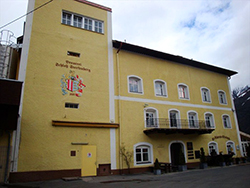 Photo:Starkenberg Photo:Starkenberg |
||||
| The castle from the 1300’s period is a beer spa and beer museum. The guests not just drinking but they can have a nice beer bath too. The owners converted the old unnecessary zymotic pools for 7 pieces of 13 meters big beer pools which can be used by the visitors. | ||||
| Az 1300-as évekből származó kastély ma sörfürdő és sörmúzeum. A vendégek nem csak fogyaszthatják a sört, de bármilyen hihetetlen fürödhetnek is a sörben. A kastélyban feleslegessé váltak az erjesztő medencék , és az átalakítás után 7 darab 13 méteres sörmedence áll a vendégek rendelkezésére az ódon falak között. | ||||
| Stainz-kastély | ||||
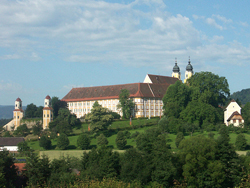 Photo: Martin Geisler Photo: Martin Geisler |
||||
|
Schloss Stainz is a former monastery of the Augustinian Canons in Stainz in Styria, Austria. Today the Baroque complex belongs to the Counts of Meran and hosts two museum collections from the Universal Museum Joanneum. In 2009 the Landwirtschaftsmuseum Schloss Stainz ("Museum of Agriculture and Forestry") also opened, displaying collections of rural Styrian folk culture. The main focus of the exhibition is on the agricultural implements and the household effects of the Styrian countryside from the Stone Age to the present. The exhibition displays objects related to the different branches of agriculture and husbandry and offers a fitting companion to the Hunting Museum. In addition to the two permanent exhibitions of the Joanneum, areas of the castle, for example the courtyard, the cellar, the arcades and the terrace, are also rented out for private events. |
||||
| 1229-ben az Ágoston-rendi apátság és templomának épülete emeltetett ide. 1785-ben II. József császár rendelettel felszámolta szerzetesrendeket, és a bírtokot II: Leopold császár fia, János főherceg vette meg. A kastély története ettől a korszaktól indul. János főherceg honosította meg a fejlett vadászkultúrát a kastély életében. Jelenleg a kastélykomplexum (Johanneum) a Merán grófok tulajdonában van, akik a főherceg leszármazottjai. A stainzi Universal Museum Joanneum foglalja össze mindazt a gazdag látnivalót, amelyet a kastélykomplexum tartogat a látogatók számára. Két jelentős gyűjteményt is meg lehet tekinteni, a mezőgazdasági múzeumot gépekkel, mező és erdőgazdaság történetével, és a vadászati múzeumot. |
||||
| St.Martin-kastély | ||||
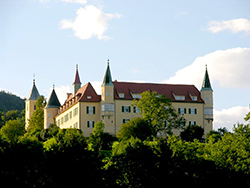 Photo: H. Moschitz Photo: H. Moschitz |
||||
|
St. Martin története az 1144-es évektől kezdődik. A kezdetekben itt egy vár és egy templom álott. 1557-től alakították ki a reneszánsz kastélyépületet .1638-tól Peter Fasoll építész vezetésével változtattak az épületen, majd a belső vártemplomot 1738-1740 között Joseph Stammel szobrász művei teszik gyönyörűvé. A kastély négyzet alakú, kétszintes árkádos épület udvarral. Mindegyik sarkán van egy négyzetes tornya az épületnek. Egykor temetkezési terület is volt a mai épület környékén. A 19. században szép kastélyparkot alakítottak ki a kastély körül. |
||||
| Tabor-kastély | ||||
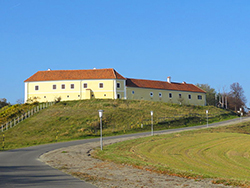 Photo: wolfi31281 Photo: wolfi31281 |
||||
| The castle was built by the mercenary leader Ulrich Pressnitzer. In 1607 the Batthyány family rebuilt it for baroque style.It was the favorite summer residence of Count Lajos Batthyányi prime minister of Hungary. During the period of 1618-48 religion war it was a protestans centre. After the II world war it was renovated. Since 1998 the Naturalpark of Rába has been the owner of the castle. It had a general renovation work between 2002-2003. Currently it is used as a gallery and a theatre. | ||||
| A kastélyt Ulrich Pressnitzer stájer zsoldosvezér építtette. 1607-ben a Batthyány-család átépítteti barokk stílusban. Gróf Batthyányi Lajos miniszterelnök kedvelt nyári pihenőhelye volt. Az 1618-48-as vallásháború idején protestáns fellegvár. 1945-ös háború után felújították, 1998 óta a Rába Natúrpark tulajdonos. 2002-2003-ban a kastélyon általános felújítást hajtottak végre. Galériaként és szabadtéri színházként is hasznosítják. (műemlékem.hu) | ||||
| Toscana-kastély-villa | ||||
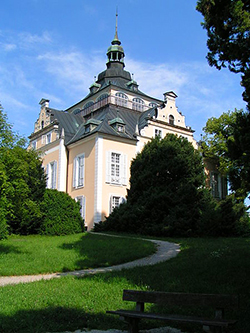 Photo: AWintscalek Photo: AWintscalek |
||||
| The villa or castle is located in the 11 hectares of park by the lake Traun. The building is influenced by style of rococo,classicist and art nouveau.The most remarkable pieces are the big atrium hall, the statue of Pompa, the coffered ceiling and the former library in the East side. The walls are decorated by Frisian paintings from the Viennese painter Christian Griepenkerf. Presently it is a café with a beautiful view to the lake. | ||||
| A villa vagy kastély a tizenegy hektáros parkosított területen áll, a Traun-tó partján. A kastély építészeti stílusában keveredik a rokokó, klasszicizmus, és a szecesszió. Figyelemre méltó a nagy átrium-szerű központi csarnok, és a Pompa szoba, a kazettás mennyezet, és a volt könyvtár a keleti oldalon. A falakat a "Art Space" a fríz festmények díszítik a bécsi festő, Christian Griepenkerl keze nyomán. Jelenleg kávézó található benne szép kilátással a tóra. | ||||
| Tratzberg-kastély | ||||
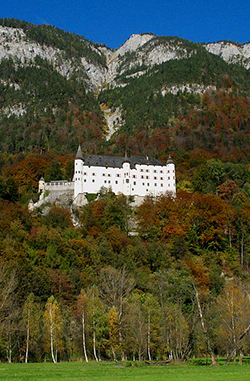 Photo: Christoph Praxmarer Photo: Christoph Praxmarer |
||||
|
Documented for the first time in the 13th century the Castle Tratzberg was used as former border stronghold against the Bavarians and as Emperor Maximilian’s I hunting lodge. In the late 15th century the former fortress was destroyed by fire. The Emperor did not rebuild Tratzberg but exchanged the ruin for a castle of the Taenzels, wealthy owners of a silver mine. They had built the first late Gothic part of today’s Castle Tratzberg in 1500, in a particularly magnificent way, with artful ornaments made of marble, wood and iron. In 1554, Georg Knight of Ilsung, a wealthy merchant from Augsburg, acquired the castle, expanded and changed Tratzberg according to the spirit of the Renaissance age. Proof of those changes is the splendidly painted courtyard and exquisite Renaissance parlours. |
||||
| Tirolban, az Inn folyó festöi völgyében, Innsbruck és Kufstein között, egy sziklatömbön emelkedik, a hatalmas, ugyanakkor varázslatosan romantikus Tratzberg, Európa legszebb késö-gótikus várkastélyainak egyike.
A Tirolban járó utazónak már messziröl szemet szúr a hatalmas müemlék-épület, – mindmáig az Enzenberg grófok rezidenciája, – mely messze nem csak a világ minden sarkából odasereglö müvészettörténészek zarándokhelye. Egy látogatás a várkastélyban, – a meglepöen szórakoztató, látványokkal teli vezetésnek köszönhetöen, – felejthetetlen élmény gyerekek és felnöttek számára egyaránt.Egy izgalmas audio-vezetés és hangjáték keretében, I. Miksa császár, a legendás Fuggerek és más történelmi nagyságok "személyesen" vezetik végig a látogatót egykori lakóhelyük ritka, értékes müremekekkel berendezett termeinek hosszú során. Búcsúzóul vendégeink, különösen a gyerekek örömére, – a fegyverteremben egy a hatalmas, kardrjával a padlót kopogtató középkori lovag, a kastély egyik 16. századbeli ura mond Istenhozzádot a sisakrácsa mögül harsogó hangon a látogatóknak. (schloss-tratzberg.a) |
||||
| Vasvörösvár-kastély | ||||
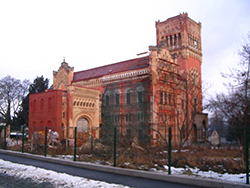 Photo: Renault25 Photo: Renault25 |
||||
| The todays castle is used be a medieval Water Castle which was surrounded by the waters of Pinka and it was destroyed around 1540. Instead of the ruin Erdődy built an old mansion here in the 17th century which was demolished in 1810.Firstly Count Istvan Erdődy commisioned the big architect Miklos Ybl to design a new castle but he didn’t adobted it. Finally it was rebuilt by the design of Antal Weber in Byzantine-Moorish style between 1862-1864. The castle has been owned by the provence since this time. | ||||
| Mai kastélyának elődje egy középkori vizivár volt, melyet a Pinka vize vett körül és 1540 körül pusztult el. Helyette az Erdődyek a 17. században építették fel a régi kastélyt, melyet 1810-ben bontottak le. 1860-ban gróf Erdődy István először Ybl Miklóst bízta meg az új kastély tervezésével, aki azt nem fogadta el. Végül 1862 és 1864 között épült fel a mai kastély Weber Antal tervei szerint bizánci-mór stílusban. A kastély 1971-óta a tartomány birtoka. ( Wiki) | ||||
| Weitra-kastély | ||||
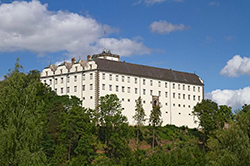 Photo: Herbert Ortner Photo: Herbert Ortner |
||||
| A first castle at Weitra was established in 1201 by the Austrian noble Hadmar II of Kuenring (or Kühnring), holder of Dürnstein castle, where King Richard the Lionheart had been imprisoned in winter 1192/93. The Kuenring family of ministeriales fell from grace after the extinction of the ruling House of Babenberg in 1246, as they had sided with King Ottokar II of Bohemia against the rising Habsburg dynasty. Ottokar II was defeated by the Habsburg king Rudolph I of Germany at the 1278 Battle on the Marchfeld, and Rudolph's son, Duke Albert I of Austria, finally acquired Weitra Castle in 1296. The fortress on the Bohemian border was seized by the Hussites as well as by Hungarian troops under Matthias Corvinus in 1486.
In 1581, Emperor Rudolf II enfeoffed Weitra to his chamberlain Wolf Rumpf. In 1607, Count Frederick IV of Fürstenberg-Heiligenberg, who had married Rumpf's widow, inherited the fief. During the Thirty Years' War, the castle was again attacked by Swedish forces under General Lennart Torstenson in 1645. The comital (from 1664 princely) House of House of Fürstenberg held Weitra until the Revolutions of 1848. The members of the Fürstenberg-Weitra cadet branch left a Renaissance castle erected on mediæval foundations, which was later rebuilt in a Baroque design. The castle was restored by the House of Fürstenberg in 1994. Beside its historic textile industry, Weitra is known as the oldest beer-producing site in Austria with several breweries documented since the 14th century. In 1903, the town received access to a narrow gauge railway line to Gmünd, since 2001 run as a heritage railway. After World War II, the economy suffered from the town's peripheral location near the Iron Curtain. Since 1959, Weitra houses a garrison of the Austrian Armed Forces. ( Wiki) |
||||
| A vár és a város története 1201-1208 -ben kezdődött. Ezt a kezdeti korszakot Hadmar II. Of Kuenring neve fémjelzi. A vár hamarosan a környék katonai, közigazgatási, igazságügyi és egyházi központja lett. Háború esetén megnyugtató védelmet adott a lakosságnak. 1581-ben Wolf Rumpf von Wiehlroß lett a vár ura, és a császári építész Pietro Ferrabosco 1590-1606, vezetésével egy csodálatos árkádos reneszánsz kastéllyá alakították át a weitrai várat. A reneszánsz kastély és a város később Friedrich von Fürstenberg tulajdona lett házasság révén, és a mai napig a Fürstenberg család, a kastély birtokosa. A kastélyban elsősorban a Fürstenberg család tulajdonából származó egyedülálló műalkotásokat, és többek között a Weitra középkori város emlékeit tekinthetjük meg, de bepillantást nyerhetünk az erdészet, a kézművesek, az úri és polgári lakáskultúra, és a plébánia és a patronátus történetébe is. A vasfüggöny korszakának bemutatása is megtalálható egy nagyobb ívű anyagban egészen a rendszerváltásig. A helyi sőrfőző-ipar legkülönfélébb tárgyai is megtekinthetők a sörrel kapcsolatos kiállításon, és a toronyból kiváló kilátást kaphatunk a környékre. |
||||
| Wiesberg-várkastély | ||||
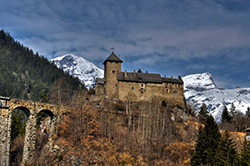 Photo: Pilago Photo: Pilago |
||||
| The castle possibly was built in the 13th century. Between 1770 and 1840 the Count Wolkenstein family was the owners. In 1602 the little gothic church was reconsecrated then in the 20th century it was renovated. We can see the bridge Trisana in front of the castle.The building is not opened for the public. | ||||
| A vár feltehetőleg a 13. században épült. 1770 és 1840 között a Wolkenstein grófok tulajdonába volt. 1602-ben újraszentelték a kis gótikus kápolnát, és a 20. században felújították. A várkastély előterében a Trisana vasúti híd látható. Az épület nem látogatható. back | ||||
| Wolsberg-kastély | ||||
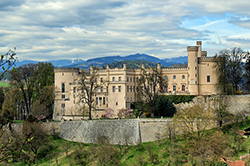 Photo:tpsdave Photo:tpsdave |
||||
The area of Wolfsberg belonged to the estates within the medieval Duchy of Carinthia that were ceded to the Prince-Bishopric of Bamberg, probably already by Emperor Henry II in 1007. The castle above the town was first mentioned as Wolfsperch in an 1178 deed of St. Paul's Abbey in the Lavanttal. The adjacent settlement became the administrative centre of Bamberg's Carinthian territories and in 1331 received town privileges by Prince-Bishop Werntho Schenk von Reicheneck. During the Protestant Reformation the Bayerhofen Castle residence, first mentioned in 1239 and rebuilt in the 16th century, became a centre of Lutheranism, which nevertheless was suppressed by the Counter-Reformation. In 1759 the Habsburg empress Maria Theresa acquired all Bamberg lands in Carinthia. Wolfsberg Castle was purchased by Count Hugo Henckel von Donnersmarck in 1846 and rebuilt in a Tudorbethan style. In World War II the village of Priel south of the town centre was the site of the Stalag XVIII-A prisoner-of-war camp with about 7,000 inmates. After the war it served as a detention camp run by the British occupation forces. (Wikipedia) The castle is a well-known cultural and events facility in Carinthia and beyond, boasting splendid rooms that hark back to ages long past. It has called into being a wide range of cultural events which attract guests from near and far to Wolfsberg. The offerings include the “Concerts à la Carte” open-air festival with performances by world-famous artists.The castle’s functions rooms can also be hired for seminars, conferences, balls, Christmas celebrations and the like. The old castle chapel lends itself ideally to weddings. Guided tours are possible by prior arrangement. A café opens at the castle during the summer months. (wolfsberg.at) |
||||
| A wolfsbergi kastélyt 1178-ban „wolfsperch” váraként említik először okiratban. Ma a Kärtner Mountanindustrie GmbH. (Karintiai Hegyiipari Kft.) tulajdonában van és a Henckel von Donnersmarck család lakja.
A nagy múltú épületet, mely változatos történelmi múltra tekint vissza, az elmúlt években renoválták, s nagy hangsúlyt fektettek arra, hogy a termek eredeti eleganciáját visszaadják. A wolfsbergi kastély messze földön híres kulturális- és rendezvényközpont, melynek csodálatos dísztermei a régmúlt időket idézik. A kastély reprezentációs termei szemináriumok, kongresszusok, bálok, karácsonyi ünnepségek stb. céljából bérbe vehetők. A régi kastélykápolna kitűnően alkalmas esküvői szertartás lebonyolítására. |
||||
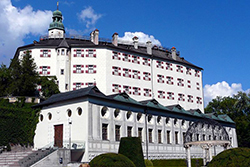 Photo:
Photo: